Why Did Kes Leave Voyager: The Tragedy Of Jennifer Lien & Her Star Trek Character
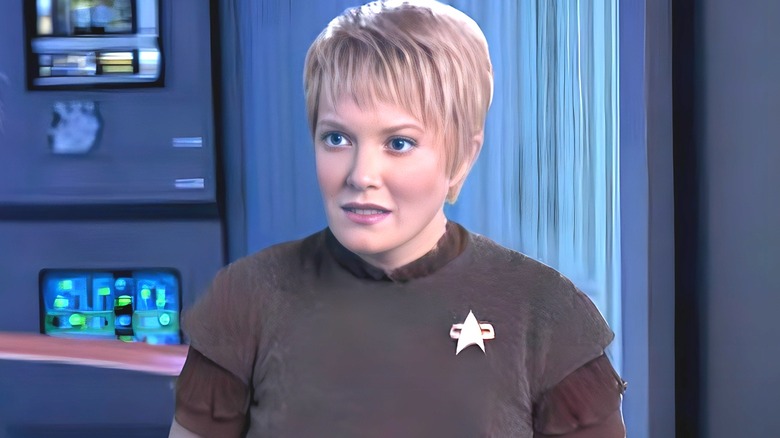
The following article discusses mental health.
When "Star Trek: Voyager" premiered in 1995, it had the virtue of subverting the brand for the better. Not only was Captain Janeway (Kate Mulgrew) the first female captain in the franchise, but the show's concept also took a turn. Instead of going on a five-year diplomatic mission famous in the "Star Trek" lexicon, the Voyager crew tries to find their way home after getting lost in the Delta Quadrant. "Voyager" had a cast of unprecedented characters , including that of the Ocampa, Kes (Jennifer Lien). Kes was fascinating because of her use of telepathy and streamlined life span of only nine years. She offered many interesting opportunities for the series, but unfortunately, it didn't come to fruition. After only three years on the show, Lien left the series — a loss for many behind the scenes.
Speaking to "Star Trek Monthly," Mulgrew said the following regarding Lien's departure: "A great sorrow to me on many levels, foremost among them being the fracturing of an ensemble cast that was extremely special to me." At the time, the reasons for Lien leaving the show were a little murky. Writers confessed to feeling they wrote themselves into a corner with her character. But in later years, a sadder truth was revealed. Lien's mental health became increasingly unstable, and despite best intentions, the "Star Trek" producers had no other option but to release her from her contract.

Lien's issues continued after leaving Star Trek
Letting Jennifer Lien go had not been the production's first choice. Though specifics on the actor's condition were never offered, she had been dealing with it for some time. As her performance started to deteriorate, the crew tried to help.
"We knew that there was something going on," producer Jeri Taylor said in "Star Trek Voyager: A Celebration," the 2020 book revolving around the series. "But she wouldn't talk or let us offer to help." With no other foreseeable options, showrunners decided to write her out of the show. Her departure occurred at the beginning of Season 4 when Kes' telepathic abilities spiral out of control, resulting in her transforming into an orb of energy.
Unfortunately for Lien, quitting acting was not the solution. The former "Voyager" star had brushes with the law, including an incident where she was arrested for indecent exposure. Per Variety , Lien exposed herself to children in 2015, reportedly resisting arrest and threatening violence against the arresting officers. After paying restitution, she stayed out of the public eye until 2018, when WATE 6 reported she was arrested for driving on a revoked license.
If you or someone you know needs help with mental health, please contact the Crisis Text Line by texting HOME to 741741, call the National Alliance on Mental Illness helpline at 1-800-950-NAMI (6264), or visit the National Institute of Mental Health website .
Star Trek: Voyager's Greatest Villains, Ranked
Here's the worst of the worst.
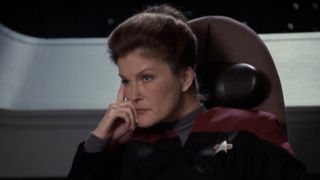
Star Trek: Voyager encountered many villainous obstacles on its long journey back to Earth, but which among these would fans consider the best? Better yet, where do they rank compared to each other?
I’ve been binging Star Trek: Voyager with my Paramount+ subscription , and feel like I have a solid lock on some of the show's best villains fans might remember. Ranked from great to greatest, here is a rundown of the worst Captain Janeway and her crew faced as they made their way through the Delta Quadrant. Given all the chatter as of late about Kate Mulgrew potentially reprising her role in live-action , it feels like as good of a time as any to remember why so many folks are still clammoring for new Voyager projects these days.
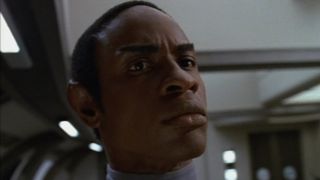
10. Angry Tuvok
Star Trek fans received a taste of an unhinged Tuvok in Season 2's “Meld,” where the crew worked to solve the mystery of a murder on the Voyager . The Vulcan, disturbed by the fact the Betazoid responsible for the crime didn’t have a motive, attempted a mind meld in order to try and understand what occurred. As a result ,he found himself with a murderous rage, and it took a good deal to get him back to his normal self.
Angry Tuvok is toward the bottom of the list because, let’s be honest, he’s not actually a villain. With that said, seeing him unhinged and out of control of his emotions shows just how dangerous Vulcans were before they committed to logic and suppressing feelings. He could easily bring Voyager down if he wanted to, so I have to commend his restraint in not doing that, or strangling Neelix to death.

9. The Nazi Hirogen
The Hirogen species had a few encounters with Voyager during the show’s run, but one particular misdeed of theirs really sticks out. The Season 4 two-parter “The Killing Game” sent the crew back to Nazi-occupied France as Janeway and the crew attempted to combat the soldiers. In reality, the Hirogen had captured them, and forced them into a holosimulation without their knowledge in an effort to enjoy the thrill of ongoing hunts.
The Nazi Hirogen, while not truly Nazis outside of the simulation, were still pretty dastardly. They used technology to brainwash the crew, and disabled safety protocols on injuries, which required the Doctor to perform operations on the crew to keep them alive between hunts. Thankfully, Harry Kim was able to free the crew by working with the Doctor, which was one of the few times Voyager made him look competent and capable .
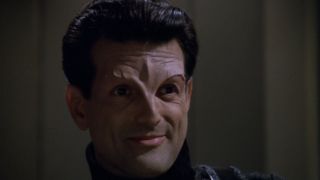
Devore inspector Kashyk from Season 5's "Counterpoint" was about as charming as he was conniving, and Janeway and crew were forced to deceive him to protect its telepathic passengers. While their initial efforts were effective, Kashyk duped Janeway by claiming he'd defected from his species, only to expose the whereabouts of the telepathic crew and capture them.
CINEMABLEND NEWSLETTER
Your Daily Blend of Entertainment News
Kashyk wasn’t the worst of the worst of Star Trek: Voyager , but he was quite a snake. He also toyed with the heart of our beloved captain at a vulnerable time in her life. Luckily, she was a bit more clever, and managed to turn the tables on him yet again. Still, the guy was just a rat bastard, and I’m glad we didn’t see him again for the rest of the series.

Some might say Seska is the primary villain tied to the Kazon, but even she suffered at the hands of Culluh. The Kazon gave the crew hell during Seasons 1 through 3, and honestly, nearly ended this mission well before it really made any progress.
What makes Culluh especially evil, however, is using Seska and his own child in a ploy to stop Voyager , under the guise that the child was Chakotay’s. Culluh’s actions ultimately resulted in Seska’s death, which was the only thing that really led Culluh to leave Voyager be.
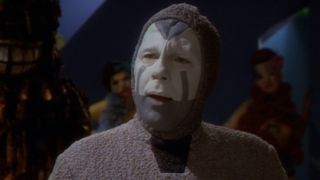
6. The Clown
Some folks will argue Season 2's “The Thaw” is one of Star Trek: Voyager ’s most frightening episodes. I wouldn’t go that far, but I will agree that one of the show’s worst villains appeared in the episode, and I’d certainly hate to come across The Clown after what he put his captives through here.
The Clown was merely a manifestation created inside of a neural network but was able to hold a group of individuals hostage in stasis for fifteen years before Voyager came along. The psychological torture is just unfathomable, and while he ultimately was defeated, there’s no doubt that the impact of his influence was felt by those affected for years to come.
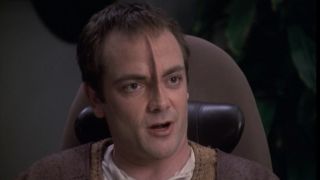
5. Icheb’s Parents
Star Trek: Voyager introduced the young refugee Borg Icheb’s parents in Season 6's “Child’s Play,” and in hindsight, we should’ve guessed they weren’t great people. After the Voyager crew convinced Icheb to reconnect with his family, it seemed like we were headed toward a happy ending. Unfortunately, we later learned that he was intentionally assimilated by the Borg, as his Brunali parents infected him with a pathogen that damaged the Borg cube and protected their people from attack.
Icheb’s parents are here on the list because they never intended to make a meaningful reconnection with their son, but rather wanted to send him out again in an effort to infect more Borg with their virus. Pretty heartless, and upsetting for viewers.
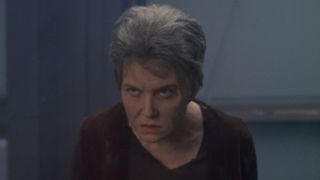
Kes was always a complicated character for Star Trek: Voyager to tackle, and it seemed the series never knew what to do with her before writing her out of the main cast. Though Lien left the series as a main cast member, she did get a return episode in Season 6's “Fury” in which Kes went on a misguided quest for revenge against Voyager .
Kes was much older due to her species’ shortened lifespan, but her psychic abilities made her effectively unstoppable. She would've succeeded, but her past self managed to talk some sense into her.

3. The Wormhole Creature
Season 5's “Bliss” offers the crew hope when they seemingly find a wormhole that will transport them instantly back to Earth. Understandably so, the entire crew was thrilled and eager to go to any lengths to make it happen, but Seven of Nine had her doubts. It soon became a battle between Seven and the rest of the crew, as she attempted to save her friends from themselves.
The wormhole creature from “Bliss” might be a wildcard choice for Star Trek: Voyager villains, but I can’t think of a more perfect creature for this list. If it wasn’t for a last-minute push from the EMH Doctor and Seven, the Voyager crew would’ve perished under the illusion they were on a fast track back to Earth. On one hand, it’s probably not the worst fate they could’ve succumbed to, but man, what a cruel fate considering all they’d been through to that point.

2. Annorax
The Star Trek: Voyager crew was brought to its knees during Season 4's “Year Of Hell,” after encountering a temporal scientist named Annorax hellbent on restoring the status of his homeworld. Janeway and the crew tried to fight back, but his weapon systems were engaged with a device capable of wiping an entire species from existence. This led the crew to be cautious, and engage in a long conflict that nearly wiped them out entirely.
The “Year Of Hell” arc is an all-time great Star Trek storyline, and part of that is due to Kurtwood Smith’s incredible performance as Annorax. One man’s quest to restore his planet’s status and bring back his wife becomes obsessive and results in the deaths of countless individuals. Thankfully, the time element managed to reset things to normal, though his impact on the crew makes him an easy choice for one of the greatest enemies Voyager ever faced.
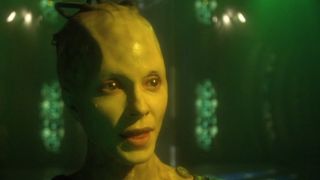
1. Borg Queen
As if there were any choice for number one, the Borg Queen stands as the definitive villain for Star Trek: Voyager . Hell, the Borg Queen is an all-time villain for the Trek franchise. There’s definitely something special about Voyager ’s connection to the Borg, and that’s largely because of the queen's encounters with Jeri Ryan ’s Seven of Nine in Seasons 5 through 7.
The Borg Queen is a master manipulator and always seemed capable of pulling just about anyone into her grasp if given the opportunity. This dynamic was so strong that it became a major part of the latest season of Star Trek: Picard , so it’s no surprise the Borg Queen reigns supreme in terms of the series' greatest villains.
Stream Star Trek: Voyager right now on Paramount+ . After that, be sure to check out Kate Mulgrew’s Janeway on Prodigy , and keep that subscription for the number of other upcoming Trek shows slated for the coming months.

Mick Joest is a Content Producer for CinemaBlend with his hand in an eclectic mix of television goodness. Star Trek is his main jam, but he also regularly reports on happenings in the world of Star Trek, WWE, Doctor Who, 90 Day Fiancé, Quantum Leap, and Big Brother. He graduated from the University of Southern Indiana with a degree in Journalism and a minor in Radio and Television. He's great at hosting panels and appearing on podcasts if given the chance as well.
An Outer Banks Star Shared BTS Photos With A Sappy Caption, And Now I’m Worried This Season Will Be The Show’s Last
Fans Are Outraged Over Kim Kardashian's Latest SKIMS Drop For Multiple Reasons
Fire Country Is Officially Getting A Spinoff, And There's One Storyline I Really Want Sheriff Country To Focus On
Most Popular
- 2 Marvel’s Fantastic Four Reboot Has Cast Paul Walter Hauser, And I Already Have An Idea On Who He Could Be Playing
- 3 After Watching Jackass Forever, I Totally Get The ‘Promise’ Johnny Knoxville Made To His Kids About Making Another Movie
- 4 Britney Spears' Hotel Stay With Boyfriend Turned Chaotic With Cops And Paramedics Called Over 'Out Of Control' Behavior
- 5 Taylor Swift’s All Too Well Almost Didn’t Make It Into The Final Cut Of The Fall Guy, And I Kind Of Wish It Hadn’t
- Cast & crew
- User reviews
- Episode aired Nov 13, 1995

The Caretaker's remains resonate, which might well mean that its mate is nearby. The trail leads to a space colony of Ocampa with psychokinetic powers. The Caretaker's remains resonate, which might well mean that its mate is nearby. The trail leads to a space colony of Ocampa with psychokinetic powers. The Caretaker's remains resonate, which might well mean that its mate is nearby. The trail leads to a space colony of Ocampa with psychokinetic powers.
- Gene Roddenberry
- Rick Berman
- Michael Piller
- Kate Mulgrew
- Robert Beltran
- Roxann Dawson
- 13 User reviews
- 6 Critic reviews

- Capt. Kathryn Janeway

- Cmdr. Chakotay

- Lt. B'Elanna Torres
- (as Roxann Biggs-Dawson)

- Lt. Tom Paris

- Ensign Harry Kim

- (uncredited)

- The Caretaker
- (archive footage)
- Kashimuro Nozawa
- Michael Piller (showrunner)
- All cast & crew
- Production, box office & more at IMDbPro
Did you know
- Trivia Gary Graham (Tanis) was once considered for the roles of both Commander Benjamin Sisko and Captain Janeway, before the decision was made for Janeway to be female and for Sisko to be African-American.
- Goofs A fly can be seen buzzing around Janeway's hair while consulting in sickbay. A Starship environment would not permit flies.
Kes : To be honest, I never want to see that part of myself again.
Lieutenant Tuvok : To which part are you referring?
Kes : To the part of me that got pleasure from destroying those plants in the airponics bay, to the part of me that was tempted to go with Tanis. I never realized I had such dark impulses.
Lieutenant Tuvok : Without the darkness, how would we recognize the light? Do not fear your negative thoughts. They are part of you. They are a part of every living being - even Vulcans.
Lieutenant Tuvok : The Vulcan heart was forged out of barbarism and violence. We learned to control it, but it is still part of us. To pretend it does not exist is to create an opportunity for it to escape.
- Connections Referenced in Inglorious Treksperts: Russ Never Sleeps: Vulcan Logic (2021)
- Soundtracks Star Trek: Voyager - Main Title Written by Jerry Goldsmith Performed by Jay Chattaway
User reviews 13
- Oct 22, 2020
- November 13, 1995 (United States)
- United States
- Official Site
- Paramount Studios - 5555 Melrose Avenue, Hollywood, Los Angeles, California, USA (Studio)
- Paramount Television
- See more company credits at IMDbPro
Technical specs
- Runtime 46 minutes
- Dolby Digital
Related news
Contribute to this page.
- IMDb Answers: Help fill gaps in our data
- Learn more about contributing
More to explore

Recently viewed
Star Trek: Voyager: Why “Fury” didn’t quite work
By rachel carrington | jan 28, 2021.
As I’ve mentioned before, I’m a first-time viewer of Star Trek: Voyager, and while I enjoy the series for the most part, there are episodes that just don’t quite work for me. The season six episode “Fury” is one of those.
Kes left Voyager after three years because her telepathic abilities were threatening the ship. Now, three more years later, she returns, and she’s angry because she couldn’t return to Ocampa. She blamed the Voyager crew. She’s back with the intention of destroying the ship. For her plan to work, she has to go back in time so she can later send a younger version of herself back to her home planet.
To me, this episode almost erased everything that Kes was, and while the writing staff of Voyager felt like there was more of Kes’ story to tell, this didn’t work. Even Bryan Fuller admitted that it was a great idea to have her play a villain but “we never quite worked it out, and it always felt a little forced.” There was supposed to be a much more in-depth explanation as to why she was so angry, but there wasn’t time for the show to explore it.
To me, the entire episode just didn’t make sense. The Voyager crew had nothing to do with Kes’ abilities, and they weren’t the reason they grew out of control. She chose to stay with the crew those entire three years, and they had no way of knowing what would happen to her eventually. Blaming her inability to return to Ocampa on them was over the top.
Origins [ ]
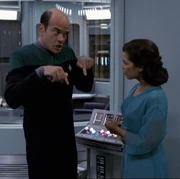
The Doctor displaying his sarcastic personality to a Qomar
The EMH Mark I was created on Jupiter Station by Dr. Lewis Zimmerman , who based the hologram's physical appearance on his own. Lieutenant Reginald Barclay also worked on the project, testing the EMH's interpersonal skills. ( VOY : " Projections ")
The EMH Mark I, upon which The Doctor's program was based, was listed as " Emergency Medical Holographic Program AK-1 Diagnostic and Surgical Subroutine Omega 323 " in Voyager 's memory. It was developed by a team of engineers to be an emergency supplement to the medical team on starships . Only meant to run for a maximum of 1,500 hours, the program included little personality and interpersonal skills. However, it was capable of treating any known injury or disease , as it was programmed with the medical knowledge of every member world in the Federation and that of over five million surgical procedures. His program even became capable of learning and adapting, in order to create new medical treatments. ( VOY : " Projections ", " The Swarm ", " Caretaker ", " Parallax ", " Cathexis ")
According to The Doctor, his original program was not configured to cry, bleed, feel pain or hunger, or to sing or dance. Neither was he programmed with reproductive organs, as he had no need for them. ( VOY : " Threshold ", " Projections ", " Body and Soul ", " Phage ", " Message in a Bottle ")
Aboard USS Voyager [ ]
The first year (2371) [ ].
The Doctor was first, albeit very briefly, activated during a ship tour with Vice Admiral Patterson by Cpt. Janeway shortly before Voyager 's launch on stardate 48038.5 in early 2371 . ( VOY : " Relativity ")
On stardate 48308.2, The Doctor was activated by Ensign Harry Kim to help treat crew members injured in the ship's violent transit to the Delta Quadrant , during which the chief medical officer and other assigned medical staff had been killed. The Doctor quickly established that the Voyager crew would be stuck with him for a while and that he would be the sole provider of medical care aboard the ship. ( VOY : " Caretaker ")
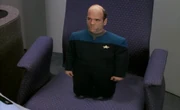
" Whatever it is, you're going to have to take care of it yourself. "
The Doctor's first few weeks as a full-time medic on Voyager were not easy for him. He had no control over his activation subroutines , so anyone could activate or deactivate his program solely at their choice. Most of the crew considered him merely a computer program or a tool, and treated him accordingly. He, in turn, was curt and rude to them, lacking empathy and bedside manner, and he was unhappy that he was being used to perform menial medical tasks. He felt that his perfection and comparative medical genius were not appreciated. When developing or performing exceptional medical procedures, he often cynically remarked that anywhere else performing such kind of a procedure would have won him a prestigious award. He was also upset at being the last one to be made aware of events that were not directly within his purview, such as the Maquis crew joining Voyager and both Neelix and Kes joining the crew. ( VOY : " Time and Again ", " Parallax ", " Shattered ", " Someone to Watch Over Me ")
When Voyager was caught in a quantum singularity , The Doctor's imaging processor began to malfunction, causing him to shrink. This malfunction was eventually repaired. ( VOY : " Parallax ", " Time and Again ")
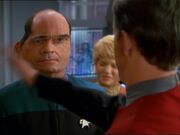
" Now, you hit me. "
One of The Doctor's first major clinical achievements on board Voyager was creating holographic lungs for Neelix . Neelix had lost his lungs to Vidiians during an organ-harvesting raid. The Doctor devised a plan to use holographic lungs to keep Neelix alive. The Doctor's idea succeeded; however, Neelix was confined to an isotropic restraint and not allowed to move, as the holographic lungs could not move. The Doctor was later able to transplant one of Kes' lungs into Neelix, with help from the Vidiians. ( VOY : " Phage ")
It was not until Kes volunteered to work with The Doctor as an assistant – and later medical student – that relations between The Doctor and most of the other crew members began to improve. It was Kes who first discovered the crew's disrespectful behavior toward The Doctor; she noticed that, just as with an item of equipment, they never addressed him directly, they barely listened to him, and often exited his presence without deactivating his program. Kes brought the matter to Captain Janeway 's attention, asking that The Doctor be treated with greater respect and granted some interpersonal autonomy. Janeway took Kes' advice to heart – somewhat reluctantly, as she herself was aware of The Doctor's questionable bedside manner – but nonetheless granted him partial control over his activation and program. He was subsequently left hurt when it was revealed that the crew were exploring a means of transporting back to the Alpha Quadrant through a small wormhole , as he was the last one to know about this development and would be left on the ship as it was impossible to download his program at this time (although the matter became academic when it was revealed that the wormhole extended into the past). ( VOY : " Eye of the Needle ")
The Doctor becomes the chief medical officer and his nurses became Kes and Tom Paris . Though it's not entirely clear when he becomes chief medical officer— there's no on-screen scene where he is promoted. In the pilot episode ( VOY : " Caretaker ") it is established that most of the medical crew is dead thus needing replacement. In the following episode ( VOY : " Parallax ") there is a scene where Captain Janeway is discussing the issue of replacing the senior officers who died including the chief medical officer. When Neelix suggests the EMH to replace the chief medical officer, Tuvok and Tom Paris give reasons why the EMH would not be sufficient for the job. Then they go right into discussing training people as field medics. The topic is not discussed again until the sixth episode of the first season ( VOY : " Eye of the Needle "), when a crew member is being rude towards the Doctor and he rebuffs by saying he is the chief medical officer and should be treated with respect. Thus it would seem that the Doctor is promoted to chief medical officer off-screen sometime between episode two and episode six of the first season.
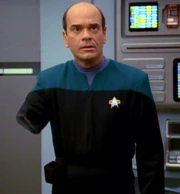
The Doctor after his first confrontation with "Grendel"
The Doctor was sent on his first away mission by Janeway, tasked with rescuing Kim, Tuvok , and Chakotay from a Beowulf holoprogram that had been invaded by a mysterious alien. Janeway's reason for deploying The Doctor on this mission was that, as a hologram, he was the only one who could not be snatched from the holodeck. The Doctor did, however, lose an arm on his first encounter with the being, which had manifested itself as the monster Grendel . Samples of photonic energy had been accidentally beamed aboard Voyager and this energy was part of the alien inhabiting the holodeck. Once returned to the alien , the crew was released. ( VOY : " Heroes and Demons ")
When the mental energy of Chakotay and the Komar was possessing members of Voyager 's crew, The Doctor was the only crew member who could not be controlled. As no one but he could be trusted, given that the Komar could inhabit anyone at any time, Janeway transferred her command codes to The Doctor so that he could countermand orders he believed were initiated due to the alien's influence. However, his program's initialization routine was later deactivated until the incident with the Komar ended. Once reactivated, the Doctor was able to reintegrate Chakotay's displaced neural energy with his body, in a procedure that required three neural transceivers, two cortical stimulators, and fifty gigaquads of computer memory, and would take about ten hours to explain to others. ( VOY : " Cathexis ")
An accident aboard Voyager once caused The Doctor to confuse illusion with reality. A hallucination of Lieutenant Reginald Barclay told The Doctor that he was real, that he was actually Lewis Zimmerman and married to a very Human Kes. The illusory Barclay persuaded The Doctor that he was held within a hologram of Voyager , with radiation after an accident having killed him. The Doctor became convinced that the only way to escape was to fire a phaser into Voyager 's warp core , an act that seemingly would result in the simulation's destruction. At the last possible second, Chakotay convinced The Doctor that he was about to destroy his own matrix. The problem was solved, although The Doctor was left intrigued as to why he had hallucinated about the nature of his existence rather than simply having had his program's defenses activated. ( VOY : " Projections ")
The same year, The Doctor diagnosed that Kes' sexual maturation, the elogium , had been prematurely activated by a swarm of space -dwelling aliens. During this period he acted in the role of Kes' father by performing the necessary rituals with her, such as the rolissisin , a ritual in which the feet are massaged until the tongue swells. Kes' elogium ended when Voyager cleared the aliens' territory. The Doctor hypothesized that the elogium had been prematurely triggered by the aliens and that Kes would still be able to conceive at her natural age of elogium . ( VOY : " Elogium ")
The second year (2372) [ ]
In 2372 , The Doctor still didn't consider himself a true member of the Voyager crew. He felt he was not being kept sufficiently informed about ship business and missions. As a result, he was forced to repeatedly open communications channels all over the ship in order to find out what was going on, an activity Captain Janeway asked him to discontinue. ( VOY : " Parturition ")
In response to criticism that he was unsympathetic to his patients, he programmed himself with the Levodian flu for twenty-nine hours to simulate the effects and to prove that a little illness should not be grounds for a constantly whiny and cranky attitude, which he accused the Voyager crew of every time they entered sickbay . Thirty hours later the simulated flu still had not cleared him, and The Doctor became fearful, feeling helpless and not in control. Kes later admitted that she had extended the simulation unbeknownst to him to teach him a real-life lesson, as it would hardly have been a real illness if he had known the outcome. ( VOY : " Tattoo ")
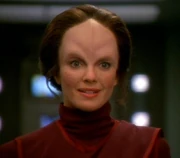
Danara Pel's holographic body
Despite initial irritations and frictions, The Doctor also experienced new things in the personal growth and romance department. When a Vidiian scientist named Danara Pel was beamed aboard Voyager to be treated, The Doctor transmitted her synaptic pathways into a hologram of her body without the disease and put her real body in stasis until he could find a cure for her breakdown. He grafted a piece of B'Elanna Torres ' brain tissue onto Pel's brain, as Klingon DNA had been found to be resistant to the phage . Over time he became attracted to her, but as he was inexperienced in the matters of the heart, he did not know how to handle his new-found emotions and confess his feelings to Denara. After receiving some advice from crew members such as Kes and Tom Paris , he overcame his initial awkwardness and took Denara on a date on the holodeck. When a cure for her condition was found and The Doctor was finally able to take Denara out of stasis, she refused, stating that she did not want to go back to that deformed body. The Doctor assured her that he loved her no matter what she looked like and that he would not want her to give up her life. The Doctor and Denara spent two weeks with one another before she met with her people and had to leave Voyager . ( VOY : " Resolutions ")
Voyager entered a plasma cloud which caused the ship and its crew to be duplicated. The Doctor was on one of the ships and delivered Ensign Samantha Wildman 's baby, who died shortly after birth. After the other ship was invaded by Vidiians, The Doctor on that ship saved that Ensign Wildman's baby, keeping it hidden from the Vidiians until that Kim and the baby could board the "first" Voyager , which they did just before their ship self-destructed , killing the Vidiians and saving the "first" Voyager . ( VOY : " Deadlock ")
When a transporter accident combined Tuvok and Neelix into a single entity named Tuvix , The Doctor found a way to separate and restore them. However, he refused to perform the procedure as he would have to kill Tuvix, a sentient being in his own right who had refused to consent to the separation. Captain Janeway eventually performed the procedure in his stead. ( VOY : " Tuvix ")
When Voyager discovered a group of alien survivors trapped in a neural network by a deranged clown-like manifestation of their own fears , The Doctor was selected as the crew's 'negotiator' as he was the only person who could access the network without being trapped in it. Although he initially failed to reason with the Clown, he was eventually able to trick the Clown into releasing his current "hostages" by claiming that Janeway would take their place, the crew in reality providing a fake Janeway. ( VOY : " The Thaw ")
The Doctor played an essential part in the defeat of the Kazon sect led by Seska and Culluh . After the crew was captured and marooned on a desolate planet , The Doctor – who escaped deletion by claiming that as a hologram he was neutral and thus did not care whether Kazon or Starfleet were in charge of Voyager – with the help of Lon Suder sabotaged the backup phaser couplings . This allowed Tom Paris and his Talaxian allies to retake the ship and save the crew. ( VOY : " Basics, Part I ", " Basics, Part II ")
The third year (2373) [ ]
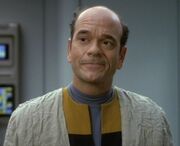
Diagnostic Program Alpha-11
In 2373 , The Doctor reached the limit of his memory capacity and started suffering massive memory loss. When an alien attack injured Paris, The Doctor was unable to treat him because his program was degrading and he was beginning to lose all of his medical knowledge. When it became evident that his program would disintegrate completely, another hologram, the Diagnostic Program Alpha-11 , was used to find the source of the problem. It was discovered that the problem was in The Doctor's core programing, which had become severely fragmented because of constant use of the EMH over the course of the past two years. The maximum operation for the EMH was intended for around 1,500 hours (roughly two months). To further complicate matters, The Doctor's expansion of his original programming to include personality subroutines and interests in things such as opera , interpersonal relationships with the crew and engineering skills had filled all of his available memory buffers, leaving little room for his program to operate in its intended function.
The captain was playing with the idea of reinitializing The Doctor's program, but that would have meant loss of all his memories and everything he had experienced over the past two years. Kes objected to just resetting him and asked the captain to try and find another solution. When no other options were found, Kes suggested overlaying the diagnostic program's programming matrix onto The Doctor's. This effectively deleted the Diagnostic program and integrated its core portions as a graft onto The Doctor's program. This procedure restored The Doctor but led to massive memory loss, including his recollection of the crews' identities and most events of the previous two years. Although some memories seemed to have survived, it was unclear if The Doctor would struggle to regain his hard-won personal skills. But some hope remained when Kes, after the reinitialization, observed The Doctor singing a song to himself; a song that was learned prior to the transfer of the Diagnostic program matrix onto his own. ( VOY : " The Swarm ")
Later that year, he assisted in stopping Henry Starling 's plan to steal a timeship which had accidentally traveled into the past, simultaneously acquiring a mobile emitter that permitted him movement beyond the limits of Voyager 's sickbay and holodeck after Starling "stole" him from Voyager to question him about their presence in this timeline, transferring him into the mobile emitter to make it easier to threaten his existence. Having escaped Starling, the Doctor rescued Chakotay and Torres from some survivalists, returned to Voyager and enjoyed his new-found freedom from sickbay, the emitter proving simple for the Doctor to use while also allowing him to be returned to sickbay. ( VOY : " Future's End ", " Future's End, Part II ") The Doctor was able to create a device to remove Ilari warlord Tieran 's consciousness from Kes. ( VOY : " Warlord ") He also helped Janeway rid Voyager of an attacking macrovirus when she returned from an away mission and the rest of the crew had been infected. ( VOY : " Macrocosm ")
In an attempt to improve himself further, The Doctor created EMH program 4C , adding personality subroutines to his holomatrix copied from many historical figures, including Lord Byron , Mahatma Gandhi , Socrates , Marie Curie , and T'Pau . Unfortunately, The Doctor didn't realize that even great historical figures had less desirable attributes and that all those, combined within his personality, would cause his program to destabilize. As a result, The Doctor began to develop a second, darker personality which exhibited callousness, anger and deceit. He attacked B'Elanna Torres, who was trying to fix his program, and rendered her immobile so she could not tell on him. He also attacked Zahir , an alien whom Kes had befriended, and kidnapped her, trying to arrange passage to another planet . Protective of and attracted to Kes, The Doctor attempted to kill Zahir, claiming that Kes' innocence required that he be there to protect her. After the failed escape attempt with Kes in tow, The Doctor was beamed back aboard Voyager , having finally lost the added subroutines and unable to remember his actions ever since the darkening in his personality had taken over. ( VOY : " Darkling ")
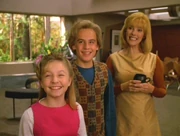
The Doctor's holographic family
Despite such incidents, The Doctor nonetheless continued to expand his programming. In order to experience human family values, he once created a holodeck family, assuming the name of "Kenneth." Initially the program was idyllic, with a devoted, loyal wife who loved chores and serving her husband and obedient children who insisted doing their homework and fought over who would say goodbye to "Daddy" first when he left for work. The Doctor was pleased, but when he invited Kes and Torres over for dinner, Torres was more than annoyed with the "lollipops" – as she called them – The Doctor had created, stating that what he had created was in no way what a family life dynamic was like. With The Doctor's permission, Torres reprogrammed it to be more realistic. In the new simulation, his wife wasn't a devoted housewife looking forward to his bringing colleagues home for dinner and his children were rebellious, undisciplined and disobedient. The Doctor was mortified at the changes, as they were not at all what he had in mind when imagining his family. He even contemplated deactivating it permanently after his 'daughter' was fatally wounded in an accident and he could not take the pain that came with losing her. However, Tom Paris helped The Doctor learn to cope with the negatives as well as the positives in having a family, and The Doctor returned to the program to mourn the loss of his daughter with his wife and son. ( VOY : " Real Life ")
The Doctor proved instrumental in assisting the crew's escape after an alien race knows as the Nyrians commandeered Voyager and relocated the ship's entire crew into an artificial environment suitable for them. Chakotay, as the last crew member on board, transferred The Doctor's program into the mobile emitter before he could be deleted. Torres subsequently modified The Doctor's optical sensors, allowing him to "see" portals between artificial environments, and with the aid of another prisoner, named Jarlath , the crew reached the Nyrians' spaceship and retook Voyager . ( VOY : " Displaced ")
The fourth year (2374) [ ]
In late 2373 - 74 , Voyager became involved in a war between the Borg and Species 8472 . Janeway made a pact with the Borg for safe passage through their space in exchange for providing them with technology that could defeat Species 8472. After Harry Kim was injured in an attack by Species 8472, his cells began to be destroyed, but The Doctor used nanoprobes to cure him by reprogramming the nanoprobes to directly attack the invading cells. This treatment enabled Voyager 's crew to develop a weapon that could be used against Species 8472, giving the crew a bargaining chip to negotiate a temporary alliance with the Borg. ( VOY : " Scorpion, Part II ")
After the alliance with the Borg ended, Janeway took in Seven of Nine , a Borg drone. The Doctor removed most of Seven's Borg implants and helped restore her to her human form. ( VOY : " Scorpion, Part II ", " The Gift ")
Like the rest of the crew, The Doctor mourned Kes' departure from the ship, as her enhanced telepathic abilities became too dangerous for her to remain aboard Voyager . ( VOY : " The Gift ")
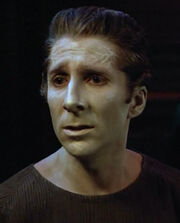
Dejaren in 2374
The Doctor and Torres answered a distress call and found a hologram named Dejaren alone on a ship. Initially The Doctor tried to befriend the hologram, sympathizing greatly with its struggles. Dejaren was eager to learn about The Doctor's freedom on Voyager , as his own crew never treated him as anything other than equipment and kept him constantly confined in one part of the ship. Eventually The Doctor and Torres discovered that Dejaren had killed his organic crew on the ship, having been driven mad by constantly being treated as a tool. After failing to convince The Doctor that holograms were a higher form of life, Dejaren tried to kill Torres and deactivate The Doctor by stealing his mobile emitter. Fortunately, Torres was able to successfully deactivate Dejaren by destabilizing his holomatrix, leaving the crew with a greater appreciation of The Doctor's personality and loyalty. ( VOY : " Revulsion ")
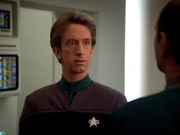
The EMH Mark II meets the EMH Mark I
The Doctor, upon his first mission to the Alpha Quadrant , was instrumental in establishing contact with Starfleet . Shortly after Voyager discovered a Hirogen communications network leading into the edge of the Quadrant, the crew attempted to send a message to a particular Starfleet vessel, the USS Prometheus , which was within range of the farthest relay. When the message failed to reach the Alpha Quadrant, however, Voyager 's crew decided to send a hologram, as it was less likely to decompile before reaching its destination. With limited time to write a completely new holographic program to send through the network before the ship moved out of range, The Doctor was the only program large enough to have a chance of making it through the network intact.
When The Doctor reached the Prometheus and discovered that the ship had been taken over by Romulans , he once again claimed holographic neutrality to escape deletion. The Doctor had to activate the experimental EMH Mark II on board the Prometheus, and despite the initial conflict between the two (the Mark II apparently thought that The Doctor was defective and obsolete, while The Doctor regarded the Mark II as an arrogant new upstart), the holograms retook control of the vessel. They accomplished this by combining The Doctor's personal experience with the Mark II's detailed knowledge of the ship. Having defeated numerous Romulan warbirds surrounding the Prometheus , Starfleet officers boarded the vessel and The Doctor was subsequently able to speak directly with Starfleet Headquarters and set the record straight about Voyager 's disappearance. The Doctor returned to Voyager , with welcome news that the ship was no longer alone. ( VOY : " Message in a Bottle ")
Later in 2374, The Doctor and Harry Kim played an important role in helping to retake the ship from the Hirogen, who were using the ship's previous crew as prey in holoprograms but had left both The Doctor and Kim free, so that The Doctor could heal the crew and Kim could work on expanding the holodecks. The Doctor was forced to treat Seven of Nine, but upon doing so he secretly added a program to her Borg components that would restore her memories during the simulation, starting a chain of events that would bring Voyager back under the control of the crew. During a Nazi program, he and Neelix persuaded the Klingons in one program to attack the Hirogen and Nazi soldiers. ( VOY : " The Killing Game ", " The Killing Game, Part II ")
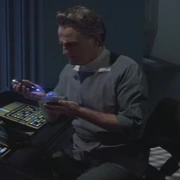
Quarren, holding The Doctor's backup module
The same year, a group of Kyrians , led by Tedran , beamed aboard the Voyager and took several people hostage. They were defeated when Tedran was killed by the Vaskan ambassador Daleth .
Several days later, Voyager was attacked by nine Kyrian ships. Several troops managed to board Voyager and stole various pieces of technology before escaping, including the EMH backup module . The devastating Great War between the Vaskans and Kyrians that followed was called The Voyager Encounter , as the official records were altered to portray the Kyrians as the victims and Voyager as the aggressors.
Seven hundred years later, a backup copy of The Doctor's program was reactivated in the Kyrian Museum of Heritage by Quarren and blamed for war crimes the crew of Voyager didn't commit. The Doctor, horrified at the museum's portrayal of Voyager 's role in the Great War, debunked the holoprogram used to teach this version of history and explained the true history of the Kyrian/Vaskan conflict, and although this caused old tensions between the two races to once again flare up, it led to a new understanding between them and eventually created a harmonious society.
This copy of The Doctor became the Kyrian Surgical Chancellor for many years after these events. Eventually, however, he left his post in a one-person ship with the aim of reaching the Alpha Quadrant, claiming that "he had a longing for home". ( VOY : " Living Witness ")
The fifth year (2375) [ ]
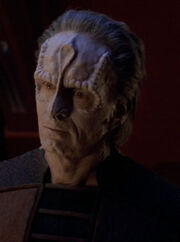
Dr. Crell Moset
In an attempt to save Torres, who had a cytoplasmic lifeform attached to her, The Doctor called upon a holoprogram of a Cardassian named Dr. Crell Moset , a renowned exobiologist in the Alpha Quadrant. Bajoran crew member Ensign Tabor informed Janeway and The Doctor that Moset had committed war crimes during the Cardassian occupation of Bajor and that he was personally responsible for the death of his father. This caused a controversy on board, as Tabor and others demanded that Moset's program be put offline and decompiled and his research obliterated altogether or else they would resign their commissions. The Doctor, unaware of Moset's reputation, was at first unwilling to delete the program and refuse Moset's help, and eventually used it to save Torres. However, as pressure from all sides kept building up and as he himself discovered that Moset's actions were unethical, he deleted the Moset program from all of Voyager 's files. ( VOY : " Nothing Human ")
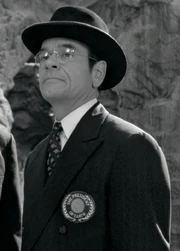
The Doctor as the President of Earth
The Doctor undertook the role of the President of Earth in the holoprogram The Adventures of Captain Proton . In doing so, he interacted with photonic lifeforms in a successful attempt to persuade them to help Captain Proton in stopping Doctor Chaotica . The Doctor even joked that he might run for office once the crew returned to Earth. ( VOY : " Bride of Chaotica! ")
That same year, The Doctor experienced a deep personal crisis of his own: He found out that memory files pertaining to an Ensign Ahni Jetal had been deleted from his program. When he confronted the crew, they reluctantly told him what had happened. Harry Kim and Jetal had been seriously injured during an away mission a few months earlier. Because The Doctor could not perform life-saving surgery on both patients simultaneously, he was forced to pick one patient, knowing that the person he was unable to treat would die. In a split-second decision, The Doctor decided to operate on Kim, thus indirectly allowing Jetal to die. Shortly after, The Doctor fell into a deep ethical crisis, questioning his decision to treat Kim and not Jetal, even though their injuries were equally fatal. He blamed himself over and over again for having been biased and helping his friend rather than Jetal, whom he was not as close to. He became caught in a loop of constantly questioning his decisions to the point where he broke down completely, unable to function. The captain decided that it would be best if the memories of Jetal and the incident be deleted. However, the truth did come out and as soon as The Doctor found out, the same pattern emerged and he found himself struggling with the same dilemma once again.
After Seven pointed out that they should not treat The Doctor like a piece of equipment but instead like the individual he had become, the captain decided that this time, instead of deleting his memories, they would stand by him and try to help him in this crisis, just as they would a friend or any other flesh-and-blood member of the crew. Janeway helped him accept his decision and realize that part of being an individual is making tough decisions and learning to live with them. ( VOY : " Latent Image ")
Later that year, The Doctor tried to give Seven of Nine social lessons on how to date. During their sessions he became quite infatuated with her, but could not bring himself to admit his feelings. He also had a small wager with Tom Paris, who had told The Doctor that Seven was incapable of going on a date without causing an incident. The Doctor told Tom that he would prove him wrong in exchange for doing a full month of sickbay duty. When Seven found out about the wager, she was disappointed in The Doctor, but she forgave him later when he apologized. When Seven told The Doctor that she no longer needed the lessons as there were no suitable mates for her on board, The Doctor was crushed about Seven's obviously not reciprocating his feelings, and he returned to the holodeck for a lonely rendition of " Someone to Watch Over Me ". ( VOY : " Someone to Watch Over Me ")
The sixth year (2376) [ ]

The weapon the crew found
In 2376 an artificial intelligence was found on a planet and the crew discovered that it was a weapon sent on a mission of destruction. The machine interfaced with The Doctor's matrix and took it over. It threatened Voyager to take it to its target. Eventually it was convinced that its mission had been an accident; its systems had been triggered by a computer error and a target had merely been selected at random. Transferring its intelligence out of The Doctor, it was beamed off Voyager and destroyed other war machines on the same obsolete mission. ( VOY : " Warhead ")
Early in the year, The Doctor was investigating the USS Equinox and was disabled by that ship's EMH, who stole his mobile emitter and returned to Voyager , posing as him.
Later, when he was reactivated by Captain Ransom , his ethical subroutines were deactivated to coerce him into extracting information from Seven of Nine.
After he was restored to himself and escaped to Voyager , Seven offered to add security measures to his program to prevent further tampering, assuring him that she bore him no ill will (she even "teasingly" informed him that he was off-key when he sang to her as he tapped into her implants). He also deleted the Equinox EMH upon returning to Voyager , although the Equinox EMH tried unsuccessfully to threaten him with holographic bombs. ( VOY : " Equinox ", " Equinox, Part II ")
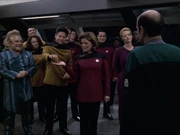
A celebration for The Doctor as he receives the Starfleet Medal of Commendation
Captain Janeway awarded The Doctor the Starfleet Medal of Commendation for his part in repelling raiders who wanted to strip Voyager of essential components. This predicament was both incited and resolved successfully thanks to The Doctor's experimentation with introducing daydreaming to his program; the aliens hacked into The Doctor's program, but due to his daydreams, they were given an exaggerated image of Voyager 's defenses and were tricked into retreating. In light of his accomplishments, Captain Janeway gave permission for research into the creation of an Emergency Command Hologram , to take command of the ship if the senior staff were ever immobilized. However, he was left more than slightly embarrassed by the fact that several of his daydreams featured Janeway, Seven, and Torres competing for his affections (as well as one where he painted Seven in the nude), although Janeway assured him that it was only human to fantasize. ( VOY : " Tinker Tenor Doctor Spy ")
The Doctor played the part of the village priest, Father Mulligan, in the Fair Haven program. When he tried to free Kim and Paris from the townsfolk, who believed they were evil spirits, he himself was captured. The townsfolk decided to hypnotize him for answers. The Doctor was highly skeptical; however, they managed to successfully hypnotize him after taking his mobile emitter away. Pressed to reveal his true name, he admitted that he "had not decided on one yet." ( VOY : " Fair Haven ", " Spirit Folk ")
Due to a time differential, The Doctor was sent to a planet with a tachyon core as, being a hologram, it wouldn't affect him. Due to problems, The Doctor spent three years on the planet, during which time he gathered information on its geologic problems, lived in an apartment with a roommate, and had a son named Jason . How he had a son is unclear, as he only said it was a long story, but when an astronaut returned to the planet to enlist their help in freeing Voyager , The Doctor requested that a message be passed on to his son's family. ( VOY : " Blink of an Eye ")
While encountering the Qomar he began singing, which awed the aliens, as they had no concept of music. He gave a recital on their planet, they asked him to stay, and he considered resigning his post as Voyager 's chief medical officer to pursue a full-time career on the Qomar homeworld . However, upon revisiting the planet, he discovered that the Qomar had made what they considered a superior holoprogram (in that it could sing notes outside the human vocal range), and that he was not wanted. He returned to Voyager , depressed at how his musical career had ended, and embarrassed at his earlier actions, but a final piece of fan mail from Seven assured him that he was still appreciated on Voyager . ( VOY : " Virtuoso ")
When Voyager encountered con artists posing as Janeway, Tuvok, and Chakotay in an attempt to make money, The Doctor proved instrumental in the recovery of the stolen property. After tricking Dala , one of the con artists, into boarding the Delta Flyer , The Doctor and Tom Paris knocked her out. The Doctor subsequently altered his holographic matrix so that he resembled Dala, allowing him to confront the other two con artists and learn where they had concealed their stolen property before turning them over to the local authorities. ( VOY : " Live Fast and Prosper ")
The final year (2377-2378) [ ]
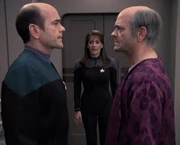
The Doctor with his creator, Lewis Zimmerman, and Deanna Troi
The second mission to the Alpha Quadrant occurred when Lewis Zimmerman was dying and The Doctor requested to be transmitted back to the Alpha Quadrant to help treat him. While he was at Jupiter Station, Lewis Zimmerman fought The Doctor and his treatment, regarding The Doctor's presence as an unpleasant reminder of his failure with the Mark I as a whole. This caused Reginald Barclay to contact Deanna Troi to help out with the situation. Neither the counselor nor Barclay could make either doctor reach any sort of agreement, as both of them were too stubborn to back down. It wasn't until The Doctor began to decompile that Lewis Zimmerman corrected the error and the two reached a mutual understanding that bordered on a father/son relationship. This was mainly reflected in a conversation where The Doctor admitted that he'd hoped Zimmerman would be proud of his accomplishments if they ever met, and Zimmerman confessed that he was grateful that at least one EMH Mark I was still doing what he had designed them for. The treatment worked, and shortly before The Doctor left for Voyager , Zimmerman told The Doctor that he could call him next time Voyager was given a chance to communicate with Earth. ( VOY : " Life Line ")
During the last year of Voyager 's journey home, The Doctor's program was stolen and sold to Dr. Chellick , who was in charge of a medical hospital on the planet Dinaali . The Doctor was appalled at the medical malpractice that was taking place. Only the rich or useful were accorded the best medical care, while others were left to die or denied medicine because of their social standing. Along with a few medical personnel, he helped change the situation, although he suffered an ethical crisis afterward. In order to convince the staff to change procedure, The Doctor had deliberately infected Chellick with a potentially fatal virus. Because Chellick was classified as a lower grade patient, he was forced to change his normal procedure to save his own life. ( VOY : " Critical Care ")
Seven of Nine and The Doctor became one when, in order to hide his matrix from aliens who hunted and destroyed holograms, he was downloaded into her cybernetic implants. He experienced the human feelings of taste and touch for the first time. Seven became angered at his 'abuse' of her body while he was in charge of her functions. The Doctor felt Seven showed excessive restraint and did not allow for superfluous pleasure, a thing that The Doctor thought was an important part of life. After they returned to Voyager, however, Seven seemed to better understand his point of view, bringing a meal to sickbay and describing the sensations of eating it to The Doctor to allow him to continue to experience it. ( VOY : " Body and Soul ")
When Voyager responded to a Hirogen distress call, the crew found that the holograms created as victims for Hirogen training had turned against the hunters. A group of these holograms had escaped to a ship and later kidnapped The Doctor. He discovered the holograms were just trying to find somewhere where they could live in peace. Eventually agreeing to help them, he escaped with them and took Torres to help the holograms set up a civilization of their own.
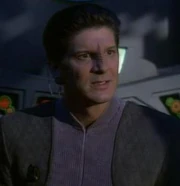
Iden in 2377
However, the holograms, led by Iden , took extraordinary measures to achieve their freedom, even going along with Iden's plan to attack and eventually destroy a mining vessel to obtain and "liberate" fellow holograms. The Doctor's suspicions about Iden were confirmed when he admitted he wished to start a new religion , with himself as the "Man of Light" having freed numerous holograms in various and often violent fashions, considering all organics as being the same despite the Doctor's protests, believing that B'Elanna displayed her prejudices when she stated that three holograms Iden had just 'liberated' were simply too basic to maintain sentience. Eventually the Doctor had to destroy Iden to protect everyone else. Ashamed of his actions, he volunteered to turn in his mobile emitter, but Janeway assured him that nobody blamed him for doing the human thing and making a mistake in judgment. The Doctor's time with these holograms had a profound effect on him. From this time on, he began to use their term "organics" and became interested in the rights of other holograms, including his " brothers ", the other, recommissionsed EMH Mark Is. A little while later, he confessed in private to Janeway that there had been a time when he would have given anything to be made of flesh and blood, but now he loved being a hologram, seeing it as superior to being organic. ( VOY : " Flesh and Blood ", " Author, Author ", " Renaissance Man ")
Shortly after this, The Doctor discovered that B'Elanna Torres was pregnant with Paris's child. At first Torres tried to reprogram The Doctor to alter the child's DNA and remove the Klingon traits, fearing a repeat of her own upbringing. While growing up she believed her father had left because he couldn't handle two Klingon women. After talking with her, Tom Paris eventually convinced Torres that he would love their children no matter what they were like and he hoped that every one of them would be just like her. After apologizing to The Doctor for reprogramming him, Torres asked him to be the child's godfather and he willingly accepted. ( VOY : " Lineage ")
When the crew was forced to transport alien prisoners to a distant planet where they would be executed for their crimes, The Doctor was appalled at the death penalty rule enforced by the planet. He also discovered that Iko , one of the patients, had actually been born with a brain defect that left him prone to violence. Using Seven's nanoprobes, The Doctor managed to cure Iko of this defect, effectively restoring Iko's conscience and making him a new person. Iko's appeal was, tragically, rejected, but The Doctor and Seven were able to take some small measure of comfort in knowing they had helped him. ( VOY : " Repentance ")
When Voyager was abandoned due to tetryon radiation flooding, Captain Janeway activated the ECH for the first time, allowing The Doctor to repair damage to the ship while the crew waited in the escape pods for Voyager to be declared safe once again. The Doctor managed to defend the ship against scavengers and had begun enacting repairs by the time Chakotay and Kim, who had been on an away mission, returned to the ship. The Doctor further demonstrated his command abilities by utilizing a photonic shockwave to disable two Quarren patrol ships . While repairing the ship along with Ensign Kim, they frequently conflicted regarding the impromptu chain of command – while Kim was actually a commissioned officer , The Doctor was programmed with the experiences of renowned commanders throughout history . Harry's strategy saved the ship from attack, and The Doctor was forced to admit that he lacked the valuable practical operational experience of other officers. He made peace with Harry before returning to his normal role as Chief Medical Officer. ( VOY : " Workforce ", " Workforce, Part II ")
After an away team became trapped on a planet with a toxic atmosphere, The Doctor was part of a rescue that was launched. The Doctor almost single-handedly rescued the entire team when he dressed as a native and infiltrated the native's caves. He explained that since he was a hologram, the radiation had no effect on him, and he was able to effectively disguise himself as part of the plan. Later on Voyager , he treated a baby infected with radiation poisoning and cured him and a native with the help of Seven of Nine. ( VOY : " Friendship One ")
The Doctor activated his command subroutines again in 2378 in an attempt to rescue Captain Janeway from the aliens who had kidnapped her. His holographic matrix altered to allow him to pose as various members of the crew, such as Janeway, Torres, and Chakotay. The Doctor was eventually able to evacuate Engineering and activate the ECH program. As the Emergency Command Hologram, The Doctor had the authorization to eject Voyager 's warp core ; he then tried to free the captain by exchanging the core as ransom. He was able to rescue Janeway and recover the core, but when the excess subroutines inserted by the aliens nearly caused his program to collapse, he made several embarrassing "deathbed" confessions including his love for Seven. Having recovered, he subsequently spent a whole week in sickbay out of sheer embarrassment but was eventually convinced by Janeway to rejoin life on the ship. ( VOY : " Renaissance Man ")
He returned to Earth when Admiral Janeway changed the timeline by going back in the past and helping Voyager return to Earth sooner than the twenty-one years it originally took. During that time The Doctor was treating Lt. Commander Tuvok's degenerative neurological disease, but kept it quiet at Tuvok's request. The Doctor's last action on the ship was to help deliver his goddaughter , Miral Paris , while in the Borg transwarp hub. As the crew were contacted by Starfleet ships, The Doctor alerted Miral's father that " There's someone here who'd like to say 'Hello'. " ( VOY : " Endgame ")
In 2381 , an irate Ensign Brad Boimler ranted to a bunch of hecklers that the Doctor shouldn’t have to justify his existence due to his experience in the Delta Quadrant and that he has rights, suggesting that the Doctor may have finally been considered sentient. ( LD : " Reflections ")
Personal interests [ ]
Identity [ ].
Motivated by Kes ' kindness, The Doctor entertained the idea of taking a name , due in part to the required prolonged existence. ( VOY : " Parallax ")
Ultimately, The Doctor has used several names on a temporary basis. Below is a list of names he used:
- Lord Schweitzer ( VOY : " Heroes and Demons ")
The first of a number of names chosen by The Doctor in honor of great medical figures of Earth's past. In this case, the name was used in order to interact with Freya and other characters in Harry Kim 's holographic recreation of the poem Beowulf ; following Freya's "death", where this name was the last thing she said to him, the Doctor discontinued using the name, finding the association with her too painful to bear.
- Shmullus ( VOY : " Lifesigns ", " Resolutions ")
Given to The Doctor by Danara Pel , named after her favorite uncle as a child who had always been able to make her laugh.
- Mozart & van Gogh ( VOY : " Before and After ")
Adopted in succession by The Doctor sometime around 2378 of an alternate timeline, during a period of interest in great cultural figures of Earth's history.
- Kenneth ( VOY : " Real Life ")
Chosen in order to interact with his holographic family.
- Joe, after Joe ( VOY : " Endgame ")
Chosen by The Doctor in 2404 of an alternate timeline, in which Voyager returned home 16 years later than it ultimately did. Apparently a permanent selection.
In addition, over the years several Voyager crewmembers such as Paris, Harry Kim , Chakotay , and B'Elanna Torres took to simply calling him "Doc." ( VOY : " Caretaker ", et al.) Kim introduced The Doctor to a holographic representation of Crell Moset , explaining that " his friends call him Doc. " ( VOY : " Nothing Human ")
He was identified to Jupiter Station's computer by Doctor Zimmerman, during The Doctor's visit in 2377, as " Voyager 's EMH". ( VOY : " Life Line ") He was also identified by Tuvok with the same designation, during the arbitration of the release of The Doctor's holonovel , Photons Be Free , when he stated to Ardon Broht that " you claim The Doctor doesn't have the legal right to control his holoprogram, yet you're promoting the fact that Voyager 's EMH wrote it. " ( VOY : " Author, Author ")
Other times he was identified as " Voyager 's doctor", once by Pete Harkins , and another time by Quarren , upon encountering The Doctor 's backup . ( VOY : " Pathfinder ", " Living Witness ")
Holo-family [ ]
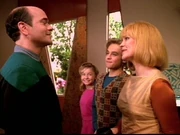
The Doctor's family
The Doctor decided to create a holographic family, Doctor's Family Program Beta-Rho , in Voyager 's holodeck in 2373 , using the name Kenneth for himself. They consisted of a wife, Charlene , and two children, a son, Jeffrey , and a daughter, Belle .
At first, family life was blissfully perfect until B'Elanna Torres "visited" the family at home and found them to be unrealistic. She altered the program, adding randomness and "realism". As a result, his teenage son Jeffrey became rebellious and began to hang out with some unsavory Klingon youths. In addition, he argued with Charlene and lost the formerly close bond he had possessed with Belle. Upon Belle's Parrises squares accident, the family came together.
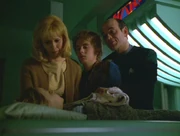
Comforting Belle
Initially apprehensive about losing her, The Doctor was persuaded by Tom Paris not to delete the program after this incident, but to work through her death with his remaining family. ( VOY : " Real Life ")
Hobbies [ ]
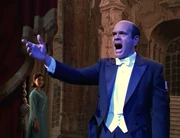
The Doctor, singing
The Doctor took a keen interest in opera , frequently practicing his singing with a holographic soprano. ( VOY : " The Swarm ")
Seven of Nine helped with The Doctor's singing capabilities when, while being held against her will on the USS Equinox , she noticed his vocal modulations deviated by 0.30 decihertz. When they returned to Voyager , she informed him of this fact and he agreed to meet her on the holodeck: " Just you, me and a tuning fork. " ( VOY : " Equinox, Part II ")
Writing [ ]
Singing was not the only creative outlet for The Doctor. He worked hard to create a holographic novel called Photons Be Free , based on an EMH on the starship Vortex and the treatment he faced from the organic members of the crew. The characters and the environment were strongly based on the crew of Voyager . After discovering his friends were concerned about his interpretation of them, he agreed to change it despite the weeks of work involved.
His publisher didn't appreciate the delay and so published the original version. In an argument with the publisher, The Doctor was told he had no rights: although he might be the author, as a hologram he wasn't a sentient being. During the subsequent debate, Janeway, Tuvok , Seven, Barclay and Kim spoke on The Doctor's behalf. Tuvok pointed out that The Doctor had created an original piece of work; Seven explained how The Doctor helped her develop as a person; Barclay compared The Doctor's aid to Zimmerman as a son seeking his father's approval; Kim explained how the Emergency Command Hologram subroutines represented a human desire to change; and Janeway cited The Doctor's defiance of her orders as a human action, something that a mere hologram – designed to obey orders – couldn't have done. At the conclusion of the 'trial', The Doctor, though not deemed a "person" at the time, was found to have the same rights as a non-holographic author and was allowed to recall the original version of the holonovel in favor of the new one when it was ready. The judge further urged The Doctor to continue his fight for sentience upon his return to Federation space. ( VOY : " Author, Author ")
Photography [ ]
The Doctor also was something of a shutterbug . He enjoyed using a holo-imager to record his experiences, times with his friends and away missions. In one instance this fascination caused him to reveal a conspiracy against him designed to suppress his memory of events that led to a loop in his programming. ( VOY : " Drone ", " Latent Image ", " Tinker Tenor Doctor Spy ", " Life Line ", " Course: Oblivion ")
Inventions [ ]
The Doctor was responsible for fashioning a fully functional prosthetic eye for Seven of Nine's left eye socket capable of rendering images nearly as clearly as her right eye. ( VOY : " The Gift ")
The mobile emitter [ ]
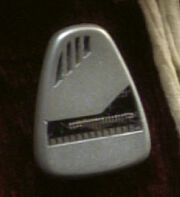
The Doctor's mobile emitter
In 2373 , Voyager encountered the Aeon under command of Captain Braxton . Due to a temporal paradox , Voyager was transported to Earth in 1996 . During this mission The Doctor obtained a piece of 29th century technology from Henry Starling, originating from the Aeon , called a mobile emitter . This device, though only a few centimeters long, was able to contain the entire EMH program and project The Doctor autonomously. After the timeline was restored and Voyager returned to the Delta Quadrant, The Doctor kept the emitter. It was quickly established that the transfer of The Doctor's program to and from the emitter would be quite easy; practically all he had to do was issue a voice command and attach the emitter to his left shoulder.
This device proved to be of vital importance and saved the crew of Voyager on numerous occasions. One of the most notable times when the emitter proved useful was shortly after The Doctor had acquired it. He helped Captain Janeway fight off a swarm of macroviruses that had infected the ship; since Janeway had been away at the time, and The Doctor (as a hologram) was naturally immune to the virus, they were forced to stand alone to save the crew. ( VOY : " Macrocosm ") The emitter also allowed The Doctor to help crew members all over the ship, which was especially useful after Kes left a short time later. ( VOY : " The Gift ")
The mobile emitter helped The Doctor to watch over the ship while the crew was in stasis during a trip through a radioactive Mutara class nebula . While proving to be helpful in allowing The Doctor to help Seven of Nine during this situation, the nebula affected the emitter, damaging its electro-optic transmitter . The Doctor, later, linked the emitter to the EPS relay network. For some time, this worked, until the EPS relays started to fail, after which the emitter went offline. ( VOY : " One ")
Due to a transporter accident, the mobile emitter was combined with some of Seven of Nine 's nanoprobes. This, combined with Ensign Mulchaey 's DNA, created a new Borg drone with 29th century technology and the mobile emitter intact as an integral part of its central nervous system . This drone called himself One and eventually sacrificed himself in order to save the crew of Voyager . Afterward, the mobile emitter was salvaged and returned to The Doctor. ( VOY : " Drone ")
On some occasions the emitter was stolen from The Doctor and/or used by rogue programs, such as Dejaren , Iden , and the reprogrammed EMH Mark I of the USS Equinox . ( VOY : " Flesh and Blood ", " Equinox, Part II ") On all occasions however, The Doctor was able to recover the emitter with no apparent side effects to his program. The mobile emitter was also used by a version of The Doctor that had corrupted files after he had attempted to improve his personality. ( VOY : " Darkling ")
Other notable occasions in which the emitter was used by holograms other than The Doctor were when the Leonardo da Vinci hologram was transferred to it after both the emitter and main computer core were stolen in a transporter attack ( VOY : " Concerning Flight ") and when The Doctor loaned the emitter to the Barclay hologram that had been received in a data stream. ( VOY : " Inside Man ") Michael Sullivan also used it to be transferred out of the holodeck and onto Voyager 's bridge, believing the emitter to be a charm to get into the spirit world. ( VOY : " Spirit Folk ")
Personal relationships [ ]
While starting out as nothing more than a piece of equipment intended to provide a short-term supplement for the existing medical team, The Doctor went on to form far greater bonds with the rest of the Voyager crew as time went on. Thanks to Kes 's initial efforts to encourage him to assert himself as a person rather than a machine, the Doctor gained control over his own activation code and was accorded all the respect and authority of a biological chief medical officer, save for the obvious detail that he remained in sickbay rather than being granted his own quarters even after the acquisition of the mobile emitter gave him the opportunity to exist outside of sickbay. The respect he received among the rest of the crew for his role as medical officer was so great that the entire crew twice sacrificed opportunities to communicate with their families so that The Doctor could deal with personal business, once when he requested that he be transmitted back to the Alpha Quadrant to try and treat the dying Lewis Zimmerman (essentially the closest person he had to a father) despite this preventing any other messages being sent back for another month, and a second time when the senior staff used their daily eleven minutes of contact with Earth to hold a court case that would determine whether The Doctor was entitled to legal rights despite his holographic status.
Friends [ ]
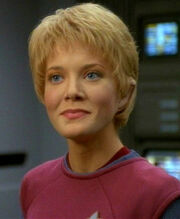
Kes in 2373
Kes was one of The Doctor's first friends on board Voyager and over the course of her stay aboard the ship, the two bonded considerably. Their friendship began early in the first year after Kes displayed great interest in medicine . This interest led The Doctor to commence training her, which brought them close as colleagues. ( VOY : " Phage ") Kes was able to quickly study the works given by The Doctor, which greatly intrigued him. Although The Doctor exhibited a terrible bedside manner and had a personality that wasn't pleasing to the rest of the crew, he reacted more kindly to Kes, treating her as a colleague and friend. ( VOY : " Eye of the Needle ") Kes in turn was always very encouraging of The Doctor, insisting that he was more than a projection and that there was no reason why he could not exceed his original programming. Kes' care for The Doctor evidently had a powerful effect on him; when his program suffered damage in 2372 and he began to hallucinate that he was his creator, Dr. Lewis Zimmerman , his hallucination included a human Kes as his wife. In that simulation, The Doctor confessed to Kes that he always found her to be beautiful during a time when "Lewis" appeared to be "dying". After The Doctor's program was recovered, he told Kes about his hallucination. Kes promised to keep what he had told her between them in case Neelix found out in another bout of jealousy. ( VOY : " Projections ")
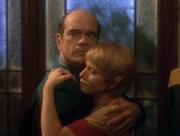
The Doctor comforts Kes in Chez Sandrine
However, romance between the two never developed, and The Doctor and Kes settled into a father/daughter relationship, with The Doctor becoming Kes' teacher and mentor during her time as a medical student and assistant. Kes' trust in The Doctor was so great that she asked him to perform the rolissisin – a ritual usually performed by the daughter's father shortly before conception – on her. ( VOY : " Elogium ")
Kes persuaded Janeway that The Doctor should be given more respect and consideration by granting him some authority over his deactivation code, a significant step towards being regarded as a full member of the crew rather than a piece of equipment. Kes always encouraged The Doctor to embrace and develop his personality, and she helped him become part of the crew. At a time when The Doctor was believed to be nothing but a program based on another program without the capacity of independent decision making, she told him that there was no difference between how he accessed his programs and made decisions for medical treatments and how she, a flesh and blood being, made decisions based on information stored inside her brain . Kes also encouraged him to pick a name and advised him when he had desperately fallen for Danara Pel but did not know how to handle those emotions. All these encouragements helped The Doctor to realize his potential. ( VOY : " Lifesigns ", " The Swarm ")
The next year Kes helped save The Doctor's matrix when, due to his program having been active far longer than it was designed for, he began to lose his memories and skills as a physician. After Torres activated a hologram of Dr. Lewis Zimmerman, he explained that The Doctor had been online too long and was deteriorating. Kes persuaded Zimmerman to graft his matrix onto The Doctor's, restoring his mental capabilities. ( VOY : " The Swarm ")
Later that year, when The Doctor's program developed a secondary, evil personality as a result of his experimenting with his personality subroutines, the "Dark Doctor", despite his deep resentments, still appeared deep down to care for Kes, albeit in a more twisted fashion than the normal Doctor. Not only did he try to kill Zahir , the alien whom Kes had developed feelings for, but he also claimed, during his capture of her, that she needed his help and protection because she was naive. ( VOY : " Darkling ")
In an alternate timeline , The Doctor told Kes that she was the finest friend he ever had. ( VOY : " Before and After ")
Seven of Nine [ ]
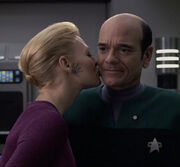
Seven gives The Doctor a friendly kiss
The Doctor was responsible for the removal of Seven's implants and also conducted her weekly maintenance sessions. He also took it upon himself to teach Seven social behavior, using the same interpersonal relationship exercises Kes once practiced with him. ( VOY : " Prey ") Later, he created a holodeck simulation of Voyager for her to become more comfortable with large social gatherings. ( VOY : " One ")
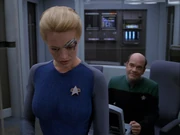
Seven of Nine and The Doctor discussing Species 8472
The Doctor encouraged Seven to explore romantic relationships in 2375 . He coached her in the basics of dating and grooming, using a lesson plan entitled " Love Amid the Stars ". He also discovered her singing voice and the two sang a duet of " You Are My Sunshine ". He was partially motivated by a wager made with Ensign Paris, who believed that Seven would not be able to bring a date to a reception planned aboard Voyager without making a scene. Although Seven's date with Lieutenant Chapman ended in disaster, she attended the reception with The Doctor and charmed the guests with a toast to individuality. However, she was hurt to discover that The Doctor's help was due to the bet. At this point, The Doctor found himself falling in love with Seven but refused to admit it to her. He tried to apologize to her but she came to him first and said she no longer needed the lessons in romance, because there were no suitable mates aboard. The Doctor was very disappointed that Seven did not reciprocate his feelings. ( VOY : " Someone to Watch Over Me ")
In 2376 , while The Doctor was stranded aboard the USS Equinox along with Seven, the crew disengaged his ethical subroutines to extract activation codes for their warp drive from Seven's cranial implants, which would leave her mentally disabled. The Doctor almost went through with the procedure, but Captain Rudolph Ransom stopped him. He apologized to Seven for the incident and she held no ill will towards him. ( VOY : " Equinox, Part II ")
The Doctor created a subroutine for daydreaming in early 2376 . Seven featured prominently in several fantasies, either serving as a damsel in distress or competing with other female Voyager crew members for The Doctor's affections. He even fantasized about painting her in the nude. When the fantasies began to overrun his program, his mental activity was tied into the holodeck, allowing Seven to see what he had been daydreaming. She did not take offense but after she kissed him following Captain Janeway's announcement that the Emergency Command Hologram subroutines would be developed, she made it clear that it was simply a platonic gesture. ( VOY : " Tinker Tenor Doctor Spy ")
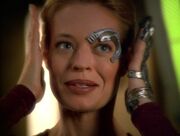
The Doctor as Seven of Nine
While Ensign Kim, Seven, and The Doctor conducted a routine survey on board the second Delta Flyer in 2377 , they were captured by a race known as the Lokirrim . The Lokirrim had waged war against holographic lifeforms who rebelled against Lokirrim rule, and as a result they banned all holographic activity within their borders. Seven transferred The Doctor's program to her cortical implant in order to hide him from the Lokirrim and prevent him from being decompiled. In the process The Doctor took control of Seven's motor abilities and was essentially trapped in her body. The Doctor tried to engineer an escape by cultivating a relationship with a Lokirrim official, Ranek , but the new sensations of taste and emotion were too tempting for The Doctor. He ended up overindulging in several foods and causing pain to Seven. Ranek later called Seven to the ship's bridge with the intention of setting up a romantic liaison. Although The Doctor was able to see his command codes, Ranek attempted to kiss him in Seven's body. Shortly afterward, he went to complain about the incident to Jaryn , a crewwoman with whom The Doctor had been working to treat injured Lokirrim crew. The Doctor became sexually aroused when Jaryn gave Seven a neck massage. Both incidents greatly irritated Seven, and once he had been returned to the mobile emitter, they got into an argument about the value of indulgence. The Doctor felt Seven showed excessive restraint and did not allow for superfluous pleasure, which he believed was an important part of life. Kim managed to return the subject to escape, and The Doctor and Seven worked together once again to transmit a distress signal to Voyager . The Doctor was downloaded back into Seven's implants and was able to convince Ranek to join her on a second date. They knocked him out at the first available opportunity and transmitted a message to Voyager including the ship's command codes. Their plan was discovered by Jaryn and Seven was taken captive. After Voyager arrived, Seven returned The Doctor's program to the mobile emitter and they escaped. Upon their return to the ship, Seven decided that The Doctor had a point about her restraint concerning pleasures such as food. She brought a meal to sickbay and described the sensations of eating it to him, allowing him to experience it vicariously. ( VOY : " Body and Soul ")
When The Doctor's rights as an individual came into question, Seven testified at the hearing conducted with Starfleet Command. She spoke highly of The Doctor, appreciative of his efforts to help her develop individuality. ( VOY : " Author, Author ")
In 2378 when The Doctor believed he was about to die, he finally admitted his feelings for her and was embarrassed when he survived. ( VOY : " Renaissance Man ") The Doctor was also crestfallen when he learned Seven had begun to date Chakotay. ( VOY : " Endgame ")
Tom Paris [ ]
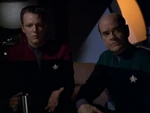
Tom Paris and The Doctor
Although their relationship was often a difficult one, The Doctor also managed to become close friends with Paris, who affectionately referred to The Doctor as "Doc" on several occasions. One of the key points in their friendship was the fact that it was Paris who helped The Doctor explore one of the most difficult aspects of being a member of the crew: relationships. When The Doctor was initially rejected by Danara Pel , he went to Paris for relationship advice and Paris helped set The Doctor and Denara up on a date in a holoprogram, informing The Doctor that his current approach to women was all wrong. ( VOY : " Lifesigns ") When The Doctor created a holographic family and one of his 'children' faced death after an accident, it was Paris who convinced The Doctor to keep running the program rather than shut it down, realizing that The Doctor needed to experience the negative aspects of family life if he wanted to develop as a person. ( VOY : " Real Life ")
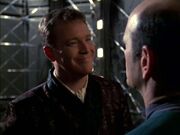
Paris turns the tables on The Doctor in his version of Photons Be Free
After Kes' departure from the ship, Paris was chosen as The Doctor's new medical assistant, serving as Voyager 's CMO when The Doctor was unavailable. Over time it became clear that, although he complained about the role, he still wanted The Doctor's respect as a person. This was the main reason Paris resented The Doctor's holonovel about abused holograms, Photons Be Free ; he worried that 'his' character, a womanizer called Lieutenant Marseilles who cheated on his wife, reflected how The Doctor saw him . Despite this, when the crew arranged a trial to determine The Doctor's legal rights after his publisher released the novel ahead of schedule, Paris objected to Tuvok 's suggestion that they claim that The Doctor had no right to sell the holonovel in the first place, as they would basically have been admitting that The Doctor was not a real person. ( VOY : " Author, Author ")
Kathryn Janeway [ ]
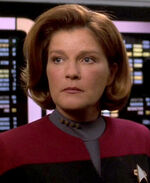
Captain Janeway
As the crew's journey unfolded, Janeway soon found herself becoming friends with The Doctor, despite initially regarding him as just another hologram. The Doctor also initially disliked Janeway, making several notes on what he regarded as her more "questionable" command decisions before he fully came to regard himself as part of the crew. As the journey unfolded however, the two of them became closer, particularly when Janeway and The Doctor were the only two crew members standing between Voyager and the macrovirus that was attacking the ship. ( VOY : " Macrocosm ")
As the journey went on, the two of them also began to develop an almost mother/son relationship, with The Doctor often coming to Janeway when he needed personal advice or information about how his program was developing, as well as consolation about any wrong decisions he had made in recent times. Janeway stopped The Doctor from deleting the additional subroutines that made him unique when he felt responsible for a death. ( VOY : " Retrospect ") Janeway assured The Doctor that none of the crew thought any less of him when he was embarrassed about the fantasies created by his daydream program, ( VOY : " Tinker Tenor Doctor Spy ") and Janeway told The Doctor that none of the crew blamed him for betraying them to try and help a crew of holograms. ( VOY : " Flesh and Blood ") As well as that, when Janeway faced death after being captured by an alien species, The Doctor risked everything to save her. ( VOY : " Renaissance Man ") When The Doctor's legal rights were questioned after his holo-novel was released ahead of schedule before he had the chance to make edits, Janeway spoke in his defense at the subsequent hearing, citing his defiance of her orders as proof that he had grown beyond his original programming where he would do nothing but follow orders, affirming that she considered him a friend as well as a member of her crew. ( VOY : " Author, Author ")
B'Elanna Torres [ ]
Although their two-way doctor/patient relationship (The Doctor treating Torres' injuries while Torres "treated" any damage sustained by his program) could be difficult at times, The Doctor and B'Elanna Torres went on to develop a surprising friendship and working relationship, such as when the two brainstormed possible solutions to help reactivate Automated Unit 3947 when he was recovered and his power was running out. Torres also helped The Doctor gain a better understanding of his new mobile emitter after he acquired it, clearly expressing her fascination with the new technology. A particularly dark period for the two was when The Doctor attempted to remove a cytoplasmic lifeform from Torres using knowledge acquired from the hologram of Crell Moset , a Cardassian doctor who had committed various war crimes. Although Torres' feelings were hurt when The Doctor dismissed her musical opinions while preparing to give a concert for the Qomar, she later convinced him not to reprogram himself to reach the high notes achievable by the Qomar's new hologram because he would be sacrificing his identity for others if he tried to reprogram himself in that manner. Their relationship became so close that, when Torres learned that she was pregnant, she asked The Doctor to be the child 's godfather, and even when faced with the possibility that she could give birth to the child on Earth in Starfleet Medical, she made it clear that she wanted The Doctor to be the supervising physician rather than some stranger. ( VOY : " Prototype ", " Future's End, Part II ", " Nothing Human ", " Virtuoso ", " Lineage ", " Endgame ")
Romance [ ]
Danara pel [ ].
In 2372 , The Doctor encountered the Vidiian Doctor Danara Pel and developed romantic feelings for her. She gave him the name Shmullus , after her uncle who always made her smile. When they met again later that year, Denara again called The Doctor "Shmullus," although he never used the name despite his fondness for it. ( VOY : " Lifesigns ", " Resolutions ")

Mareeza [ ]
Four years later, Voyager became trapped in orbit around a planet where time advanced at a much faster rate than normal. The Doctor determined that the transition into this accelerated timeframe could be fatal to a humanoid and so volunteered to transport to the surface himself. It was intended that he would only spend three seconds on the planet which equated to around two days on the surface but attempts to transport him back to Voyager failed. Chakotay guessed that The Doctor would spend his time in the city's cultural center and he was located a short time after being transported down. However, to The Doctor, he had spent three years on the surface. He met a woman named Mareeza , whom he later described as his "roommate", and had a son named Jason Tabreez . ( VOY : " Blink of an Eye ")
Alternate Doctors [ ]
Holographic recreations [ ].
The Doctor was holographically duplicated on a number of occasions.
- The entire crew of Voyager was recreated by Tuvok from his Insurrection Alpha program, including The Doctor. ( VOY : " Worst Case Scenario ")
- Harry Kim attempted to recreate the Doctor when he was transmitted to the USS Prometheus in 2374 , but the new program, identified as the Emergency Medical Hologram Replacement Program , was unable to function properly and it collapsed. ( VOY : " Message in a Bottle ")
- Reginald Barclay recreated The Doctor in 2376. ( VOY : " Pathfinder ")
- Various miniature copies of The Doctor were created by the Qomar due to their admiration for The Doctor's singing. ( VOY : " Virtuoso ")
- Harry Kim and Seven of Nine projected The Doctor's daydreams into the holodeck in order to better understand what was malfunctioning. In this daydream, The Doctor wore a painter's smock and beret while he painted a holographic representation of Seven in the nude. ( VOY : " Tinker Tenor Doctor Spy ")
- After he stole The Doctor's program, Gar left a copy – created from one of The Doctor's old training files – aboard the starship to cover his tracks. ( VOY : " Critical Care ")
- In 2378 , Seven recreated the crew of Voyager to perfect her social skills, including The Doctor. ( VOY : " Human Error ")
- The Doctor served as the narrator of his own holonovel , Photons Be Free , set aboard the USS Vortex , which was based on the crew of the USS Voyager , albeit the names were changed to protect the innocent. ( VOY : " Author, Author ")
- A holodeck recreation of The Doctor by Tom Paris in his rendition of the holonovel Photons Be Free in 2378. ( VOY : " Author, Author ")
Alternate realities and timelines [ ]
Dr. van gogh [ ].
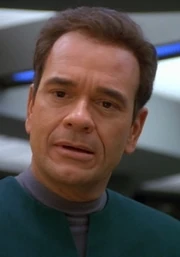
In the possible future that Kes experienced when she began to travel backwards in time, The Doctor was offline for months during the " Year of Hell " conflict. When his program was restored, The Doctor developed a full head of hair, chose the name "Doctor Van Gogh" (although he briefly thought about calling himself Mozart) and tried to develop a means of extending Kes' life via use of a bio-temporal chamber which triggered her jumps back through time. Subsequently – or previously, depending on perspective – The Doctor of the present cured her of her sudden jumps back in time and this timeline never came to pass. ( VOY : " Before and After ")
Voyager crashed [ ]
In an alternate timeline where Voyager crashed into an ice planet while attempting to reach Earth via the use of a quantum slipstream drive, The Doctor's program was recovered fifteen years later by Chakotay and Harry Kim, who had been in the Delta Flyer when the crash took place, the two managing to reactivate sickbay's holographic emitters long enough to transfer the Doctor into his mobile emitter. Though at first reluctant due to the Temporal Prime Directive , The Doctor agreed to help as he wanted his friends to survive as well. With The Doctor's help, they managed to devise a means of transmitting information back in time to Seven of Nine's cortical implant before Voyager was destroyed, hoping to save the crew by stabilizing the slipstream and allowing them to reach Earth. After the attempt failed, it was The Doctor who made a tearful, defeated Kim realize that Voyager 's salvation lay outside the slipstream, and to use the link to end the flight rather than prolong it; if they couldn't get Voyager home, they could at least save the ship and her crew. With the Flyer 's warp core about to breach and rapidly running out of power to send the data, The Doctor volunteered the use of his emitter as a power source. Kim wished The Doctor goodbye before removing the emitter. This timeline was erased when Kim, moments before the Flyer exploded, successfully transmitted the data to Seven of Nine that would shut down the slipstream drive, with a message from Harry to his past self the only trace left of that history. ( VOY : " Timeless ")
Shattered Voyager [ ]
When Voyager was fractured into multiple different time periods, sickbay reverted to stardate 49624, a year prior to the acquisition of the mobile emitter. Despite his relative "youth", The Doctor of this time period was able to devise a chroniton-infused serum that would stabilize the temporal instability experienced by Commander Chakotay after the initial accident, as well as allow him to travel between the fractured time periods of the ship. Once he learned what had happened from Chakotay, The Doctor provided him with more samples of the serum, allowing Chakotay to "recruit" Janeway from a time before Voyager was sent to the Delta Quadrant, with this Janeway being surprised when she met The Doctor and witnessed his level of development compared to the original EMH program. When Chakotay's plan was able to undo the original accident, the timeline was altered so that The Doctor never experienced these events. ( VOY : " Shattered ")
Original 25th century [ ]
In the aborted timeline where Voyager took twenty-three years to return to the Alpha Quadrant, two weeks prior to the ten-year anniversary of the ship's return, The Doctor married a Human woman named Lana and even took the name of her grandfather, Joe . He remained the personal physician of Admiral Janeway, who credited her fine health to his exceptional care over the years, and continued to visit Tuvok to monitor his neural degradation. ( VOY : " Endgame ")
Memorable quotes [ ]
" Please state the nature of the medical emergency. "
" Doesn't anyone know how to turn off the program when they leave?!? "
" It seems I've found myself on the Voyage of the Damned. "
" Who would have thought that this eclectic group of voyagers could actually become a family? Starfleet , Maquis , Klingon , Talaxian , Hologram , Borg , even Mr. Paris... "
" The computer sounds like it needs a stimulant. "
" Sticks and stones won't break my bones, so you can imagine how I feel about being called names. "
" Activate the photonic cannon . "
" Interesting sensation blowing one's nose; it's my first time."
" "I've reconfigured The Doctor's optical sensors and as soon as they're aligned he should be able to detect the microwave signature of the portals. " " Then I can begin my new career as a tricorder. "
" What did he ingest? " " Just a cup of Neelix' coffee. " " It's a miracle he's still alive.... "
" You claim that you're my friend but you don't even call me by my name. " " That's because you don't have a name. " " No name? That's ridiculous! I'm… My… I demand you tell me my name! "
" I'll go first, captain, and draw their fire if need be. " " Your crew is heroic, captain. " " I just happen to be invulnerable to phaser fire, but I appreciate the compliment. Captain? " " Go. "
I'm a doctor, not a... [ ]
- " I'm a doctor, Mr. Neelix , not a decorator. " ( VOY : " Phage ")
- " I'm a doctor, not a bartender . " ( VOY : " Twisted ")
- " I'm a doctor, not a voyeur. " ( VOY : " Parturition ")
- " I shouldn't have to remind you: I'm a doctor... "
- " I'm a doctor, not a performer. " ( VOY : " Investigations ")
- " I'm a doctor, not a counterinsurgent. " ( VOY : " Basics, Part II ")
- " I'm a doctor, not a database . "
- " I'm a doctor, not a peeping Tom; there's nothing I haven't seen before. " (when catching Lt. Torres in the sonic shower) ( VOY : " Drone ")
- " I'm a doctor, not a battery. " ( VOY : " Gravity ")
- " I'm a doctor, not a dragonslayer . " ( VOY : " Bliss ")
- " I'm a doctor, not a zookeeper. " ( VOY : " Life Line ")
- " I'm a doctor, not an engineer. " ( VOY : " Flesh and Blood ")
Appendices [ ]
Appearances [ ].
- " Caretaker "
- " Parallax "
- " Time and Again "
- " The Cloud "
- " Eye of the Needle "
- " Ex Post Facto "
- " Emanations "
- " State of Flux "
- " Heroes and Demons "
- " Cathexis "
- " Learning Curve "
- " The 37's "
- " Initiations "
- " Projections "
- " Elogium "
- " Twisted "
- " Parturition "
- " Persistence of Vision "
- " Cold Fire "
- " Maneuvers "
- " Prototype "
- " Alliances "
- " Threshold "
- " Dreadnought "
- " Death Wish "
- " Lifesigns "
- " Investigations "
- " Deadlock "
- " Innocence "
- " The Thaw "
- " Resolutions "
- " Basics, Part I "
- " Basics, Part II "
- " Flashback "
- " The Chute "
- " The Swarm "
- " False Profits "
- " Remember "
- " Sacred Ground "
- " Future's End "
- " Future's End, Part II "
- " Warlord "
- " The Q and the Grey "
- " Macrocosm "
- " Fair Trade "
- " Alter Ego "
- " Blood Fever "
- " Darkling "
- " Favorite Son "
- " Before and After "
- " Real Life "
- " Distant Origin "
- " Displaced "
- " Worst Case Scenario "
- " Scorpion "
- " Scorpion, Part II "
- " The Gift "
- " Nemesis "
- " Revulsion "
- " The Raven "
- " Scientific Method "
- " Year of Hell "
- " Year of Hell, Part II "
- " Random Thoughts "
- " Concerning Flight "
- " Mortal Coil "
- " Waking Moments "
- " Message in a Bottle "
- " Hunters "
- " Retrospect "
- " The Killing Game "
- " The Killing Game, Part II "
- " Vis à Vis "
- " The Omega Directive "
- " Unforgettable "
- " Living Witness "
- " Hope and Fear "
- " Extreme Risk "
- " In the Flesh "
- " Once Upon a Time "
- " Timeless "
- " Infinite Regress "
- " Nothing Human "
- " Thirty Days "
- " Counterpoint "
- " Latent Image "
- " Bride of Chaotica! "
- " Gravity "
- " Dark Frontier "
- " The Disease "
- " Course: Oblivion "
- " The Fight "
- " Think Tank "
- " Juggernaut "
- " Someone to Watch Over Me "
- " Relativity "
- " Warhead "
- " Equinox "
- " Equinox, Part II "
- " Survival Instinct "
- " Barge of the Dead "
- " Tinker Tenor Doctor Spy "
- " Riddles "
- " Dragon's Teeth "
- " One Small Step "
- " The Voyager Conspiracy "
- " Pathfinder "
- " Fair Haven "
- " Blink of an Eye "
- " Virtuoso "
- " Memorial "
- " Tsunkatse "
- " Collective "
- " Spirit Folk "
- " Ashes to Ashes "
- " Child's Play "
- " Good Shepherd "
- " Live Fast and Prosper "
- " Life Line "
- " The Haunting of Deck Twelve "
- " Unimatrix Zero "
- " Unimatrix Zero, Part II "
- " Imperfection "
- " Repression "
- " Critical Care "
- " Inside Man "
- " Body and Soul "
- " Flesh and Blood "
- " Nightingale "
- " Shattered "
- " Lineage "
- " Repentance "
- " Prophecy "
- " The Void "
- " Workforce "
- " Workforce, Part II "
- " Human Error "
- " Author, Author "
- " Friendship One "
- " Natural Law "
- " Homestead "
- " Renaissance Man "
- " Endgame "
Background information [ ]
The Doctor was played by actor Robert Picardo . The part of The Doctor disguised as a Hierarchy overlooker, in the episode " Renaissance Man ", was played by J.R. Quinonez (see also: Roles with multiple performers ).
The Doctor was created with the intention of essentially being an "outsider" who could comment on humanity from that perspective, much like how Spock , Data and Odo had been established in Star Trek: The Original Series , Star Trek: The Next Generation , and Star Trek: Deep Space Nine respectively. ( A Vision of the Future - Star Trek: Voyager , pp. 167-168)
An early reference to the character concept that eventually became The Doctor was included in a series of notes that Executive Producer and Star Trek: Voyager co-creator Jeri Taylor wrote on 30 July 1993 . The reference was listed among other subjects which had been covered during one of many developmental discussions she had with fellow Executive Producers Michael Piller and Rick Berman about the series (which was yet to be named). Specifically, this list included a mention of "Holo-Moriarty", referencing the Moriarty hologram from the Star Trek: The Next Generation episodes " Elementary, Dear Data " and " Ship In A Bottle ". ( A Vision of the Future - Star Trek: Voyager , pp. 175 & 179)
In another compilation of notes Jeri Taylor wrote a week later (on 3 August 1993 ), she included an outline of the character in a section titled "The Crew". The outline stated, " Holo-Doctor –A human or alien male or female (possibly Vulcan?) The medical officer of the ship is killed during the mission; remaining is the holographic character of the doctor who, like Moriarty, has 'awareness' of himself as a holodeck fiction. He longs for the time when he can walk free of the Holodeck. (Some discussion about the fact that one of the crew must become a 'student' of this doctor. Maybe one of the misfits [i.e., a Maquis] had been kicked out of medical school.) " ( A Vision of the Future - Star Trek: Voyager , pp. 175, 176 & 177)
At this point, the three executive producers liked the concept of the doctor character. They therefore considered how they could explain or justify, in a way that would be sufficiently credible to the viewers, the character's existence, if he was to be a holographic yet sentient being, so that it fit with what had previously been established. This was evident in another summary of Jeri Taylor's notes, this time dated 6 August 1993. Reporting more character development for The Doctor, the document stated, " The Holo-Doctor represents a new, state-of-the-art technology which has capitalized on the serendipitous incident which created Moriarty, and has programmed a holographic character which has self-awareness of his situation and limitations. " As the notes continued, they clarified that the team of series co-creators had discussed the idea that The Doctor had been made "a bit bland" when his programmer had created him, leading one of the "misfits" (a conn officer, who ultimately developed into the character of Chief Engineer B'Elanna Torres) to decide to tweak his personality programming during the mission. The team had also considered that the hologram may have been created by Reginald Barclay , designed in his own image, and that, while taking a leave of absence in an upcoming TNG episode , he could put "the polishing touches" to the program. ( A Vision of the Future - Star Trek: Voyager , pp. 182 & 183)
In several early first-season Star Trek: Voyager scripts, call sheets, and shooting schedules and during the pre-production phase, the character of The Doctor was referred to by name as "Doc Zimmerman" after Herman Zimmerman , since the show's producers had not yet decided to leave him unnamed. ( VOY Season 2 DVD trivia text version of " The 37's " ) His initial description in the script for VOY : " Caretaker " originated this routine, as The Doctor was therein initially referred to " as a holographic man in a Starfleet medical uniform […] He has no name for now… but we will get to know him in time as Doc Zimmerman. His manner is colorless, dry. " The character continued to be referred to as having the name "Zimmerman" in all the scripts which were written for the series' first season, and "Zimmerman" was reported to the public as the character's name in press materials during the series' initial production run. Robert Picardo claimed in October 2022 that it was his decision to rename the character in the credits, with a view to the Doctor choosing the name "Doc Zimmerman" in a later episode. [1]
As a continued in-joke and reference to the character's original name, the terms "zimmers in" and "zimmers out" were used behind the scenes and in stage directions to refer to the distinctive effect of the Doctor's materialization into and dematerialization out of a scene. ( Star Trek: Voyager Companion (p. 176))
In the special features on the Voyager DVD collection, Robert Picardo mentions that he ad-libbed during his audition for the role of The Doctor, adding the line, " I'm a doctor, not a lightbulb " at the end of his script; he says that he "got a laugh" from the assembled studio executives, even though ad-libbing isn't something that's generally done on a Star Trek production.
It was only once the scripts started to be written for VOY Season 2 that this character became officially known as "The Doctor". He is one of two ongoing characters in science fiction who are referred to by this title, as opposed to a proper name; the other is the protagonist of the long-running British television series Doctor Who .
Many people, including Robert Picardo himself, were initially opposed to Brannon Braga 's idea of the mobile emitter, believing The Doctor's limitations to be one of the appeals of the character. However, Picardo ultimately relished the opportunities for growth of his character due to The Doctor's newfound mobility, without noticing any negative impact to his appeal to the fans ; Picardo subsequently apologized to Braga. ( Star Trek: Voyager Companion (p. 452))
Many fans have wondered if Robert Picardo actually did all of his singing himself. To answer that question, Picardo said, " I did all of my singing except for the second half of 'Virtuoso'. The Don Carlo duet and Rondine al Nido are voiced by an opera singer, Augostino Castellnano (I hope I spelled that correctly). He's a terrific guy. I simply couldn't sing high enough or well enough to pull them off, but I did my own singing in 'The Swarm', 'Tinker, Tenor...', 'Renaissance Man', 'Someone to Watch Over Me' and all the others. " [2] (X)
Robert Picardo also appeared as The Doctor in "Borg Invasion 4D" at Star Trek: The Experience and also portrayed other EMHs in Star Trek: First Contact , DS9 : " Doctor Bashir, I Presume ", and VOY : " Author, Author ".
Apocrypha [ ]
Robert Picardo has written a book based on and as told by his character, named The Hologram's Handbook . Picardo goes into depth about how he felt about various experiences while aboard Voyager , such as feeling "betrayed" by Kes when she extended the length of his bout with the flu, as well as genuine and helpful advice for any holograms finding it hard to fit in with 'organics'.
In Star Trek: Voyager - String Theory : Evolution , The Doctor is sent into Ocampa's distant past by a Nacene, which transfers him into the body of a recently-deceased Ocampan soldier, allowing him to experience the sensations of an organic body for the first time, although the conditions are so harsh that he cannot fully enjoy the experience. He is eventually returned to his time after meeting with Kes to oversee the birth of an Ocampan/Nacene hybrid.
In the Voyager relaunch book series, The Doctor became a famous proponent of holographic rights and eventually joined a Federation "think tank" with Seven of Nine. Following the events of the Destiny trilogy, The Doctor became chief surgeon of the Project Full Circle fleet, returning to the Delta Quadrant on a specialized medical ship he assisted in designing. He is subsequently the first member of the original Voyager crew to greet the resurrected Admiral Kathryn Janeway when she is restored to life by Q and Kes in The Eternal Tide . Following the discovery that Seven had formed a relationship with the Full Circle fleet's new counselor, The Doctor was reprogrammed by Zimmerman to move on from his old feelings for her, Zimmerman arguing that he was just accelerating the process of recovery that The Doctor would have gone through on his own, ( Protectors ) but a later attempt to defeat an alien life form forces The Doctor to trap the entity in a part of his program and erase his memories of Seven, leaving him unable to even recall most of the time they have spent together. ( Atonement )
In the "Borg Invasion 4D" attraction at Star Trek: The Experience , The Doctor is the lead physician on board Copernicus Station on the edge of the Alpha and Delta Quadrants. While testing a group of people (the audience members) whose DNA apparently resists Borg nanoprobes, the station comes under assault by the Borg themselves. After the group of hopefuls is captured and in the process of assimilation, The Doctor breaks through the hallucination that the Borg Queen is projecting and informs them that help is on the way. Minutes later, Admiral Kathryn Janeway and the USS Voyager rescue the group and bring them back to safety. The story is helped by interactive 3D projections and real live actors. In the video segments, Robert Picardo reprises his role as The Doctor, as do Kate Mulgrew and Alice Krige for Admiral Janeway and the Borg Queen, respectively.
The Doctor (voiced by Robert Picardo) is one of several Voyager cast members who reprise their roles in the Delta Rising expansion of Star Trek Online , along with Tim Russ (Tuvok), Ethan Phillips (Neelix), Garrett Wang (Harry Kim), Jeri Ryan (Seven of Nine), and later Robert Duncan McNeill (Tom Paris). Players meet The Doctor several times as they explore the Delta Quadrant thirty years after Voyager first explored the region.
External links [ ]
- The Doctor at StarTrek.com
- Doctor (Star Trek: Voyager) at Wikipedia
- The Doctor at Memory Beta , the wiki for licensed Star Trek works
- The Doctor at the Star Trek Online Wiki
- 2 ISS Enterprise (NCC-1701)
- Show Spoilers
- Night Vision
- Sticky Header
- Highlight Links

Follow TV Tropes
http://tvtropes.org/pmwiki/pmwiki.php/Recap/StarTrekVoyagerS3E9Warlord
Recap / Star Trek Voyager S 3 E 9 "Warlord"
Edit locked.

This episode contains the following tropes:
- Almost Kiss : Tieran is interrupted just as he's about to kiss his wife in Kes's body.
- Ambiguously Bi : Tieran takes to flirting with and kissing other men very quickly after assuming control of Kes's body.
- Antagonist Title
- Armor-Piercing Question : Tieran/Kes tells Ameron he's taking over as Autarch. When Ameron says that his elder brother is the rightful heir, Tieran/Kes asks, "How many times have people said the very same thing to you?"
- Kes gives as good as she gets too:
- Bait-and-Switch Comment : A partially nonverbal one: Neelix watches Tom and Harry make changes to his spa holoprogram with a rather nonplussed expression, suggesting he’s disgruntled about the casual pool party atmosphere they’re creating... but it turns out he actually loves it!
- Battle Discretion Shot : The offscreen battle between Voyager in alliance with Demmas' forces, vs the forces supporting Tieran/Kes. We only see the action once Janeway and the others beam into the Imperial Hall.
- Beneath the Mask : Given that Kes breaks up with Neelix permanently, the implication is that Tieran/Kes was saying what Kes was secretly thinking about their relationship.
- Beware the Nice Ones Kes: You're losing, Tieran. Why won't you admit it? Tieran: I will admit that you surprised me. Who would have imagined that such fierce determination existed within that deceptively frail body?
- Big "NO!" : Tieran shouts this when breaking free of Tuvok's Mind Meld .
- Blood from Every Orifice : And given that the Ilari have more than the usual number of nasal orifices for a Psychic Nosebleed , it can get rather messy.
- Body Snatcher : The other people possessed by Tieran were volunteers (presumably recruited from his more fanatical followers) but he jumps into Kes because he's dying on the medical table and Kes is standing over him. His surgeon urges him to transfer to a more willing host, but Tieran is reluctant to give up Kes' powers (or admit he's been forced out of his body by a little girl ).
- Body Surf : While dictator, Tieran spent a major part of the planets' resources on research into how to become immortal, and now has the ability to move his consciousness to another person.
- Break the Cutie Kes: Everything seems so different now. My thoughts and perceptions, even my relationships with my closest friends. You, the Doctor, Neelix... How can I go back to my normal life as if nothing ever happened? Tuvok: You cannot. This experience will force you to adapt. You are no longer the same person, and the course of your life will change as a result. Where that new course leads, is up to you.
- Call-Back : Tom says "Some day you're going to show me how to do that" after watching Tuvok give the Vulcan nerve-pinch to a guard. The same comment was made by Kirk to Spock in "The Omega Glory". Their working together is also a Call-Back to "Future's End".
- Circling Monologue : Tieran is fond of this (as is expected of a villain) but Kes does the same to him in their Battle in the Center of the Mind .
- Curb-Stomp Battle : Offscreen. With Voyager assisting Demmas' fleet, Tieran/Kes's own ships are hopelessly outmatched. Voyager is able to smash through them and start landing troops within minutes of the battle beginning.
- Cute and Psycho : General Resh isn't impressed when his fearsome leader turns out to inhabiting the body of a female alien waif. Tieran quickly demonstrates he's not to be fucked with in any body, especially one with psychic powers that make you bleed from your facial orifices .
- Decapitated Army : Why Janeway wants to concentrate her efforts on removing Tieran from Kes; it will avoid Voyager having to take sides in a Civil War ( Voyager takes sides anyway, but the producers keep that carefully offscreen ).
- Kes. Not even a Body Snatcher can stop Kes from being a Badass Adorable .
- Tieran is no slouch either, as evidenced in his Badass Boast . Say what you will about him , but giving up is not one of his character flaws.
- Discount Lesbians : Tieran almost kisses Nori in Kes's body and still behaves as if he has romantic interest in her even though he is a man's mind inside of a woman's body. Nori admits that his new body really complicates her feelings about their marriage (presumably, she's straight).
- Dressing as the Enemy : Tuvok tries to get close to Tieran/Kes by dressing as one of his Faceless Goons , but Tieran/Kes recognises his thoughts from their sessions on Voyager .
- Dutch Angle : During the mental battle between Tieran and Kes.
- Evil Costume Switch : Once Tieran takes power, Kes changes into a black Spy Catsuit that would make Mirror Universe Kira proud.
- Evil Feels Good : During his Battle in the Center of the Mind , Tieran tries to tempt Kes over to his side by talking of how wonderful it is to wield ultimate power. He does the same thing earlier with Ameron (with more success).
- Evil Is Hammy : Oh, My Gods! yes — Jennifier Lien swaggers, vamps and rants at everyone in sight.
- Evil Sounds Deep : When Tieran is in control, Kes' voice is noticeably deeper.
- Fanservice : Chez Sandrine is replaced by Neelix's Paxau Resort program (with Hotter and Sexier modifications by Tom, Harry and B'Elanna), all so the audience can see the cast in swimsuits, plus some gratuitous Fanservice Extras .
- Female Gaze : Neelix worries that B'Elanna might not like his new holodeck program due to all the babes Harry and Tom recently added. She replies that she's made her own additions, whereupon a handsome, well-muscled masseur in tiny shorts drapes a towel around her neck .
- Fighting from the Inside : Kes fights Tieran from inside her mind.
- Foot Focus : The teaser features at least two close ups of Neelix's Talaxian spotted feet.
- Forceful Kiss : After taunting Tuvok over his desires for Kes, Tieran/Kes grabs him for a passionate snog, which is a mistake because it enables Tuvok to start a Mind Meld .
- Foreshadowing : Like " Cold Fire ", this episode hints at a Dark Side to Kes that will come out fully in "Fury".
- Freudian Excuse Is No Excuse : Tieran rants over how he was abandoned on the streets by his parents because he was assumed to be too sickly to survive. Kes: I know all about your life. I know about your suffering. It doesn't justify what you've become. You're a monster , Tieran, and I have no compassion for you .
- High Collar of Doom : The Autarch's symbol of office is a metal collar. Immediately after gunning down the previous Autarch, Tieran/Kes takes the collar from his corpse and puts it around her own throat, bringing this trope into play.
- I Fight for the Strongest Side! : Although Demmas is the rightful ruler after his father is assassinated, he points out that many will support Tieran because he appears stronger, including his weak-willed younger brother Ameron. It's for this reason he wants the technologically superior Voyager to fight on his side.
- I Gave My Word : Tieran gives this as his reason for letting Voyager depart in peace, despite Demmas' presence on board. It's actually because Kes is influencing him, but there's no way in hell he would admit that to anyone, least of all himself.
- "I Know You Are in There Somewhere" Fight : Tuvok is able to Mind Meld with Tieran, briefly bringing Kes to the surface, advising her on how to defeat Tieran.
- Innocent Flower Girl : Just to remind us of her innocent nature before she turns evil, our first sight of Kes in this episode is of her attending to plants in her quarters. Tieran gets a shock when he suddenly finds himself going on about the pleasures of gardening and issuing an edict that all his subjects should have one.
- Instant Expert : Tieran almost immediately begins using Kes's Psychic Powers with amazing proficiency, even though his description of them as "unique" implies that he has never possessed a host body with such powers before. Once he is gone from her mind, Kes cannot use her powers the way Tieran did.
- Jerkass Has a Point : As Kes, Tieran breaks up with Neelix by telling him that he's too possessive and jealous to allow her to have any life of her own outside of his involvement. Tieran is only doing this to facilitate his escape, but he has access to Kes's memories, and he's completely right. Neelix's critical flaw throughout the show so far has been his jealousy.
- Large Ham : Tieran, Demmas and Resh.
- Last-Second Word Swap : Kes & Tieran re Tuvok/Kes . "All those hours you spent alone together, all that time you spent touching each others...minds."
- Kes, oh yes. At the end of her mind-battle, she makes even a 200-year old warlord back up against the wall in fear.
- Neelix insists on going on the mission to free her.
- Madness Mantra : "This momentary lapse will pass and I'll be stronger than ever! Stronger than ever! Stronger than ever... Stronger than..."
- Mood Whiplash : Kes, who for all appearances is normal despite a tense break-up with Neelix, suddenly draws a phaser and kills an alien diplomat and Voyager 's transporter chief.
- No Good Deed Goes Unpunished : Captain Janeway saves some aliens, only for them to murder a Red Shirt and take over Kes.
- And with Tieran Kes himself; s/he's going around the Imperial Hall tearing down wall hangings and smashing vases ...until s/he comes to a flower vase. As Kes keeps Fighting from the Inside , these lapses in behaviour become more obvious.
- Not Quite Dead : Tieran is forced out of Kes, but Kes realises he had time to Body Surf to Ameron and presses the synaptic stimulator against his skin. Cue a scream of fear and rage as Tieran finally gets his comeuppance.
- Not So Stoic : Tieran Kes is able to slip past Tuvok's mental barriers and read the emotions beneath his urbane Vulcan exterior — embarrassment over having failed his mission, concern about her advanced mental powers, anger (which she identifies as Tuvok's Fatal Flaw ), and (she suggests) desire for her .
- Oh, Crap! : The look on Ameron's face when Kes introduces 'himself'. Kes Tieran: You and I haven't had a chance to get acquainted. I'm Tieran. Ameron: Tieran?!! Kes Tieran: (smirks) I like the way you say that.
- One-Man Army : When launching his coup d'etat, Tieran bursts into the Imperial Hall and guns down three bodyguards plus a couple of servants .
- Playing Possum : A guard gets the drop on Tom Paris this way.
- President for Life : Tieran started off as a great military leader who brought stability to a troubled world. Unfortunately, he not only refused to relinquish this power, but he also tried to achieve immortality due to the belief that he was the only man capable of ruling the planet.
- Properly Paranoid : The Autarch sends someone else up to meet Nori and Adin on Voyager, though it only delays his assassination a few hours.
- Really 700 Years Old : Tieran is over 200 years old, which is quite old for most species, who all seem to have lifespans comparable to humans unless specifically mentioned. Compared to Kes, who is only about three years old, this is quite ancient.
- Red Shirt : The transporter chief is killed by Tieran Kes during her escape.
- Rule of Symbolism : Tieran craves sleep because Kes keeps haunting his dreams. In their Battle in the Center of the Mind Kes first appears standing in front of a bed. Also the side where Kes stands is her quarters on Voyager , while Tieran's side is the Imperial Hall. By the end of the dream, the entire room is Kes' quarters.
- Sanity Slippage : Tieran starts to go off the deep end the more Kes waylays his mind.
- Second Law of Gender-Bending : Tieran finds that possessing an attractive female body gives him a useful weapon in the struggle for power. He even announces a political marriage to Ameron, then strongly implies to his squicked-out wife Nori that he'd be quite interested in a threesome .
- Ship Sinking : Kes breaks up with Neelix, but because it happened under Tieran's influence, it took several episodes before the audience realised they were no longer an Official Couple . Given that this is Voyager , neither character hooked up with anyone else (despite some Kes/Tuvok Ship Tease in this very episode).
- Ship Tease : Tieran Kes tries to seduce Tuvok, suggesting that with all those times sharing Kes' mind in their private sessions, he must have come to desire her .
- Superpowered Evil Side : Tieran is able to make use of Kes' Psychic Powers much more effectively than Kes. So Tuvok advises Kes to tap into Tieran's strengths and make them her own. She takes the advice to heart. Tieran: You may resist and try to fight me, but eventually I will defeat you. I haven't existed for two centuries to be brought down by a child! Kes: You're already deteriorating and it's only going to get worse . I'll find every little crack in your defences. You'll feel yourself crumbling from within, your sanity slipping away . I won't stop until you're broken and helpless. There's nowhere you can go to get away from me. I'll be relentless, and merciless, just-like-you!
- Swiss-Cheese Security : Justified — the assassination and escape is made from the transporter room, enabling Kes!Tieran to beam a shuttle from its bay into space, then themselves onto the shuttle. Tieran has all of Kes' knowledge plus several days to plot things in advance, so he's able to block the crew's attempts to shut down the transporter beam, lock on a tractor beam or track the shuttle after it goes to warp .
- Torture Always Works Tuvok: You know that I will not provide you with any information. Kes Tieran: You'd be surprised how often I've heard that.
- Umbrella Drink : Tom Paris turns all the Gallia nectar drinks in the Paxau Resort into Rekarri Starbursts.
- Villainous Breakdown : In his Back Story , Tieran was only defeated after a destructive year-long siege of the Imperial Hall. By the third act this famous military leader wastes time on frivolities and paranoid ranting instead of coordinating his defenses or organizing a fighting retreat, so they're quickly overwhelmed.
- We Can Rule Together : Offered to both Ameron and Kes.
- Why Don't You Just Shoot Him? : Demmas has little patience with Captain Janeway's attempts to drive Tieran out of Kes with the synaptic stimulator, which has to be pressed against the skin to work. "If I could get anywhere near her, I'd use a thoron rifle to be absolutely sure ."
- With All Due Respect Resh: The Voyager is leaving orbit. Kes Tieran: Let them go. Resh: Yes sir, but, with all due respect; why?
- You Killed My Father : When Ameron points this out, Tieran quips, "Let's not dwell on the past."
- Star Trek: Voyager S3E8 "Future's End"
- Recap/Star Trek: Voyager
- Star Trek: Voyager S3 E10: "The Q and the Grey"
Important Links
- Action Adventure
- Commercials
- Crime & Punishment
- Professional Wrestling
- Speculative Fiction
- Sports Story
- Animation (Western)
- Music And Sound Effects
- Print Media
- Sequential Art
- Tabletop Games
- Applied Phlebotinum
- Characterization
- Characters As Device
- Narrative Devices
- British Telly
- The Contributors
- Creator Speak
- Derivative Works
- Laws And Formulas
- Show Business
- Split Personality
- Truth And Lies
- Truth In Television
- Fate And Prophecy
- Edit Reasons
- Isolated Pages
- Images List
- Recent Videos
- Crowner Activity
- Un-typed Pages
- Recent Page Type Changes
- Trope Entry
- Character Sheet
- Playing With
- Creating New Redirects
- Cross Wicking
- Tips for Editing
- Text Formatting Rules
- Handling Spoilers
- Administrivia
- Trope Repair Shop
- Image Pickin'
Advertisement:
Star Trek: Voyager - What Made Kes and Neelix’s Relationship So Inappropriate?
Exploring some of the toxic relationship traits displayed in Star Trek: Voyager by the franchise's least favorite chef.
When it comes to the wild and wonderful world of Star Trek, there are some series that are a greater hit with audiences than others. The Original Series is a classic, setting up the franchise with an explosion of wonderful sci-fi, but for a lot of fans, the actual storytelling and characters fall flat. The Next Generation is heralded for many as the best series of classic Trek. Meanwhile, Deep Space 9 left audiences with a new appreciation for the dark themes the franchise could reach, stretching the limitations of morality in the dire situations forged in times of war .
Voyager, however, disappointed many when it came out. While the show has gained some more appreciation over the years, it still remains a dark spot on the report card for the older series. There is a lot that the program did wrong, from unflinching acts akin to criminal from Captain Janeway , to some of the worst episodes in Star Trek history . However, what pushed many viewers over the edge was the character of Neelix, and his vastly inappropriate relationship with Kes.
RELATED: Best Episodes of Star Trek: Voyager
Kes was a character who started out with a lot of potential, but quickly spiraled into a convoluted and often flat story arc. It turned out to be a blessing when she left the show early (especially considering she was replaced by the brilliant Seven of Nine). Kes was an Ocampan, a race of beings that had a much shorter lifespan than most other humanoids, with a life expectancy of around eight or nine. This short life led to accelerated aging, rapidly growing from infant to fully grown person in the space of a year. When Neelix and Kes joined the the crew of Voyager , Kes did so with the knowledge that she would never see her home again, but she was ready for the adventure and the chance to see the galaxy in the short years she had left. She was two years old at the time, the human equivalent of being around 20 years old.
The problem a lot of fans have with the on-and-off romantic relationship between Neelix and Kes was the humongous age gap between the two characters. Neelix was in his 30s, while Kes was just two years old. By human standards, this is down right criminal, but the important thing to remember is that Kes is not human. She had only been alive for two years, yes, but by the rules of her own race she was a fully grown woman. She was fully capable of consent, as she possesses an adult mind and body. It would be the equivalent of a Vulcan, who often live to the age of 200, being disgusted at a 60-year-old Vulcan dating a 20-year-old human. 20-year-olds in Vulcan culture are considered very young, but for a human, this perspective seems relatively normal.
Kes' limited years also resulted in a limited amount of understanding of the world. Ocampans learn very quickly, and Kes was as smart as many aboard the ship despite her young age, even becoming an assistant to the holographic life form Doctor . However, with only one real year of adulthood under her belt, its likely she could have been easily coerced by Neelix and his persuasive want for her companionship. He took her onboard a spaceship where she would never see another member of her race for as long as she lived, missing out on the chance to mate (which for Ocampans happens once in their lifetime). Before meeting him, she was already a victim of abuse from the Kazon. Her life before Neelix had been a short traumatic childhood in a sheltered microcosm, followed by a period of captivity. While she may have been old enough to consent to a relationship, her psychological state brings this into question.
However, the majority of the above could be argued away based on the fact that they’re aliens. The biggest problem in their relationship was that Neelix often treated Kes like he owned her. He was, in many ways, abusive, not physically but often emotionally. He pushed his will onto her from a very early age and then continued to control her when she became old enough to live her own life and make her own decisions. He is shown to be incredibly possessive over her, resulting in a full, testosterone-filled brawl between Neelix and Tom Paris after the latter showed her too much attention. Neelix came across as a slimy, jealous character a lot of the time. While Kes did eventually outgrow him, and they split up in a moment pioneered by her, it felt less sad and more of a relief that audiences won't have to be subjected to their uncomfortable relationship anymore.
MORE: Star Trek: Exploring Klingon’s Unique Warp Technology
- Buy the Book…
- Reviews Hub

the m0vie blog

Following Us
- Adding Our RSS Feed to Your Gmail
- Following our Feed in Internet Explorer
- Millennium (Reviews)
- Star Trek: Deep Space Nine (Reviews)
- Star Trek: Enterprise (Reviews)
- Star Trek: The Next Generation (Reviews)
- Star Trek: The Original Series (Reviews)
- Star Trek: Voyager (Reviews)
- The X-Files (Reviews)
- X-Files Fandom Poll Form
Check out the Archives

Awards & Nominations

Star Trek: Voyager – Darkling (Review)
There is something to be said for the pulpier side of Star Trek: Voyager , the aspect of the show that plays like a cheesy sci-fi b-movie.
Brannon Braga is very much the driving force behind this aspect of the show, as evidenced by his scripts for the belated Cold War body-swapping horror of Cathexis or the psychological nightmare of Projections or the trashy psychedelic terror of Cold Fire or even the weird evolutionary anxieties of Threshold and Macrocosm . These sorts of episodes often feel like they belong in a late night movie slot reserved for forgotten horror flicks from the fifties and sixties. Of course, Braga is not alone in this; episodes like Meld and The Thaw also fit the pattern.

Blurred lines.
Of course, these episodes do not always hit the mark. Charitably, it could be argued that they land about half the time and misfire spectacularly about one third of the time. However, there is something strangely compelling about these episode. They feel distinct from what audiences expect from Star Trek . Even if they are arguably just an extension of late Star Trek: The Next Generation episodes like Sub Rosa or Genesis or Eye of the Beholder , they feel like something different from the show’s more conventional “let’s do archetypal Star Trek” plotting.
Darkling is an episode that doesn’t quite work, but which is oddly endearing in its dysfunction. It is a ridiculous central premise executed in a deeply flawed (and occasionally uncomfortable) manner. However, there is something weirdly compelling about wedding the show’s science-fiction premise to gothic horror through the fractured psyche of a computer program.

Darkling is a surprisingly gothic episode, even considering the obvious influence of The Strange Case of Doctor Jekyll and Mister Hyde on the script. A lot of that is down to the choice of setting. Voyager visits a trading outpost on a remote world, a planet that seems to consist entirely of mountains and forests populated by an entire species of wanderers. The episode opens on Janeway sitting inside an old-style tavern, with a fireplace burning brightly behind her. She is being regaled with stories of mystery and wonder by the local innkeeper.
“The hours past, the air grew cold, and with our weapons we started a fire to keep warm,” narrates Nakahn. “Later, in the night, we awoke with a shudder. The ground was shaking.” Janeway is clearly caught up in the narrative, as ridiculous as it might seem. His tale recalls the narratives crafted by sailors, a myth that treats the cosmos as place of infinite wonder beholden more to magic than rational science. It certainly does an effective job establishing a tone for the rest of Darkling .
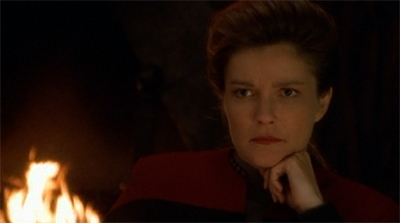
Fuel for the fire.
Of course, there is something faintly frustrating in all of this. As ever, Voyager consciously retreats from the bolder promise of earlier episodes. Much like Voyager pulled back the mystery and intrigue teased by the new frontier in Fair Trade , the show recoils from the tease of the Borg buried in the final few moments of Blood Fever and the threat posed in Unity . The very premise of Darkling insists upon “business as usual” , Voyager visiting a strange new world like they would on any other week.
“Our guests are offering us supplies we need,” Zahir advises Nakahn. “In exchange we Travellers are giving them a look at what lies ahead of them. We should keep that view as clear as possible.” In theory, Janeway should already knows what lies ahead. The Borg Collective loom in the distance, the single largest threat in the Star Trek canon. As such, it is quite disheartening to see Voyager back to bumping into random aliens again. Surely the Borg have pillaged and destroyed any civilisations living this close to their territory?

Travellers’ tavern.
The subject of the Borg never comes up. Instead, Zahir offers generic advice about the other alien species living in the region. “You should navigate here, away from this plasma belt, you’ll avoid the Tarkan sentries altogether,” Zahir explains to Tuvok. Tuvok responds, “It would also take Voyager off a direct course to the Alpha Quadrant.” The crew really should have bigger things to worry about. After all, the looming threat of the Borg should probably feel like the pending threat of the Dominion War on Star Trek: Deep Space Nine .
Allowing for this issue, which plagues the rest of the show’s third season, Darkling does a great job of establishing mood. Zahir takes Kes on a magical evening walk through a forest following a mountain path. The characters all dress in old-fashioned robes, while the killer conceals his identity with a ridiculous hood. Beaming back to the ship, the EMH draws attention to the absurdity of the costuming. “Why I’m wearing these ridiculous clothes?” he demands of the ominous gown that his doppelganger had chosen.

All good in the hood.
Even the Mikhal Travellers themselves feel like they were lifted from a nineteenth century gothic horror story. The name sounds suitably Eastern European, recalling the landscape of tales like Dracula . The nomadic lifestyle of the Mikhal recalls that of the Roma community, the gypsies who seem to populate classic horror narratives. Indeed, even the makeup design cements this idea by reference to the larger Star Trek canon. The Mikhal are distinguished by nose ridges; this recalls the Bajorans, franchise’s most high profile displaced species.
The plotting of Darkling is also something of a throwback. The episode builds to a climactic confrontation on the edge of a cliff, a literal cliffhanger. This is a touch that harks back to old pulpy adventures, evoking everything from Sherlock Holmes and James Moriarty throwing themselves over the cliff in The Final Problem to the deaths of Disney villains like Gaston in Beauty and the Beast or the Queen from Snow White and the Seven Dwarfs . It is such a classic trope that it seems almost quaint in the context of Star Trek .

That falling feeling.
As the special effects used to realise the giant viral monsters in Macrocosm , the computer-generated imagery in Darkling has not aged particularly well. The climactic scenes look more than a little ridiculous, particularly the wide shots of the evil! EMH forcing Kes across the narrow edge and the shots of the pair falling to their potential doom. These sequences feel almost stylised, looking quite animated. The result is something that looks like it belongs in a much older piece of entertainment, perhaps even a black-and-white film.
Even the premise of the episode feels very much like an homage to a very retro school of horror. The EMH decides to upgrade his programming by copying subroutines drawn from a variety of historical figures, from Mahatma Gandhi to Lord George Byron to T’Pau of Vulcan. Inevitably, it all goes spectacularly wrong. It creates a monstrous alter ego for the EMH, a monster denoted by his slumped posture and his unkempt hair. It is a classic horror movie transformation, one that recalls the werewolf or Mister Hyde.

Cliffhanger.
As with so many of these classic horror movie villains, there is something decidedly creepier lurking just beneath the surface of the literal transformation. Many of those nineteenth century horror classics, from Frankenstein to The Strange Case of Doctor Jekyll and Mister Hyde to Dracula , layer their monstrous characters with suggestions of something more carnal and unsettling. Reproductive and sexual horror tends to ripple just beneath the surface of these tales, with horror providing a metaphor through which these ideas might be explored.
The original novels were informed by the cultural mores of nineteenth-century Britain, where topics of sex and sexuality were certainly never openly discussed. When these novels were originally adapted for the silver screen in the twentieth century, there were similar forces at work. The Hayes Code prevented films from directly engaging with ideas of sexual expression and deviance. So that simmered underneath polished exteriors, with directors like James Whale burying queer themes in films like The Invisible Man and Bride of Frankenstein .

“Somebody needs a Doctor!”
There is certainly an element of that to Darkling , which seems appropriate. It is written by Joe Menosky from a story that he drafted with writer Brannon Braga. Both writers have a long interest in themes of psychology and identity; Braga in stories like Frame of Mind and Flashback , Menosky in Masks and The Thaw , together in Remember , The Killing Game, Part I and The Killing Game, Part II . It makes sense that the writers would be drawn to the grotesque and stylised psychodrama suggested by Darkling .
Indeed, over the course of Voyager , Braga seems particularly interested in the idea of the EMH as a character with a very transparent and literal subconscious as reflected by the fact that he is comprised entirely of computer algorithms. Unlike human characters, it is quite easy to get inside the head of the EMH. Unraveling the EMH’s frame of mind is as simple as debugging lines of code. Braga plays with this idea in scripts like Projections and in his manipulation of the EMH’s psychology in scripts like Latent Image or Equinox, Part II .

Empty philosophy.
To be fair, the EMH is not the only computer-based individual subject to such psychological exploration. The seventh season of The Next Generation ventured into the subconscious of Data in Phantasms and of the Enterprise itself in Emergence , both episodes that could be seen to foreshadow Voyager ‘s treatment of the EMH. Seven of Nine undergoes similar technology-related breakdowns in episodes like Retrospect , One , Infinite Regress , The Voyager Conspiracy and Human Error .
However, it does seem that holographic characters on Voyager are particularly subject to such breakdowns. The EMH already had a complete mental breakdown in The Swarm , but will also encounter other holographic lifeforms afflicted by severe psychological conditions. In Revulsion , Dejaren demonstrates severe obsessive-compulsive disorder and murders his organic crew members. In Flesh and Blood, Part I and Flesh and Blood, Part II , Iden develops a messiah complex and suggests that his fellow holograms should worship him.

“I’d love to have you my table.”
Unsurprisingly, given the interests of Braga and Menosky, early drafts of Darkling were loaded with psycho-sexual subtext. As Menosky explained to Cinefantastique :
We originally made The Doctor perversely sexual and sadistic. There was a sense that his attachment to Kes was weirdly kind of psycho-sexual, and we took it to its limit. In the screenplay first draft that I wrote, I had a scene when Kes walks into the holodeck and sees The Doctor doing an experiment. There are Keses everywhere, and he’s got one of them on the operating table, and he has some flip line about, ‘Just trying to get to know you better.’ It’s very perverse.
There are certainly elements of that bleeding through into the final cut of the episode, with a decidedly sexual subtext to the evil! EMH. He is undoubtedly more violent and aggressive than his alter ego, but he also seems more perverse than his relatively innocent counterpart.

“Gandhi’s not in favour of having a gander.”
After all, the introduction to the EMH’s attempts at enhancing his personality finds Gandhi lecturing about the importance of sexual restraint and repression. “Men and women should refrain from enjoying each other,” Gandhi insists. “By that I mean to say, even their mutual glances must be free of all suggestion of carnality.” Gandhi seems to urge a sexless world, perhaps one that resembles the relatively sterile twenty-fourth century as portrayed on the Berman-era Star Trek shows.
It is suggested that the evil! EMH is in someway a product of all that repression. “I was born of the hidden, the suppressed,” he insists, a rather poetic piece of dialogue. Then again, most monsters are born of those things; it is easier to process that which makes us uncomfortable when filtered through the fantastical. In some ways, Darkling seems to be touching up the themes left half-developed in Blood Fever . The evil! EMH is the ultimate expression of pent-up sexual frustration, a raging id motivated my carnal desire.

Somehow, the fact that Starfleet never bothered to programme workplace harassment guidelines into the EMH is not surprising.
Even before the malfunctions become clear, it is suggested that the EMH is undergoing some sort of sexual awakening. When Torres reports to Sickbay suffering from heartburn, the EMH engages in some casual workplace harassment. “In my preparatory report to the away team, I recall mentioning to you that Klingons lacked an enzyme for metabolising this planet’s vegetation,” he reflects. He leans in close, almost whispering, “Have you been naughty?” This is before his transformation.
This creepy subtext only grows stronger once the EMH actually begins to transform into the evil! EMH. There is something decidedly creepy in the way that the evil! EMH chooses to torture Torres as she lies paralysed on his bio-bed. “I’ve paralysed you from the waist down,” he suggests. “You’re now in my capable hands.” He creepily runs his finger up her thigh, framing the threat in sexual terms. Later on, the evil! EMH stalks an anonymous female Ensign and plots to kidnap Kes.

“The thighs have it.”
To be fair, sex and sexuality have long been an interest of Brannon Braga. After all, the writer was responsible for the Borg Queen in Star Trek: First Contact and the creation of Seven of Nine, both female characters who could be defined as “cybernetic dominatrices.” Indeed, the writer has a long-stated interest in exploring the kinky side of Star Trek :
Braga has been at Paramount for five years and has worked on more than 150 episodes, seeing his ideas shot down and reworked by half a dozen people. If he could write one show entirely on his own – total freedom, no one else involved – what would he do? “That’s easy.” Braga grins, and slides the hefty tome into his satchel. “I’ve always wondered what people really do on the Holodeck.”
In some ways, Darkling could be seen as a slight variation on that original pitch; it is a story about what really goes on inside the mind of a hologram. During the show’s original run, Braga had an acknowledged fondness for collecting pornography and “raunchy art.” As such, it makes sense that some of that would bleed into his work on the show.

Falling for Kes.
There is something to be said for being willing to talk candidly about sex and sexuality, as Blood Fever halfheartedly argued. Darkling touches on the idea of sexual awakening, hinting at the sexual development of Kes through her flirtations with Zahir. Late at night, she walks through an empty forest with him. It is like a scene from a fairy tale. The episode is reasonably explicit about what is happening. “How about an understanding?” she teases. “A meeting of the minds?” Zahir responds, “Only minds?”
Repeatedly over the course of Darkling , male characters are forced to confront the fact that Kes is growing up. Tuvok makes note of Kes arriving back on the ship at a late hour. “It is three o’clock in the morning, Kes,” he states. “You have an away team report due at oh eight hundred hours.” Similarly, the EMH complains, “Gallivanting around after hours is beside the point. The fact is, you’re becoming increasingly unpredictable, given to swings of mood and emotion.”

Kes from a rose.
The recurring suggestion is that Kes has found herself at the cusp of womanhood, between being a girl and being a woman. The male characters struggle to adapt to that. Tuvok is protective; when Kes suggests traveling with Zahir, Tuvok seems wary. After Zahir warns of the dangers lurking in a particular region, Tuvok inquires, “You aren’t planning on taking Kes anywhere near this part of space?” Kes is shown to be going through something approaching her late teenage years; staying out late with boys, considering leaving home.
Kes explicitly acknowledges this in her conversations with the EMH. “Doctor, I know that you care about me and that you have my best interests at heart, but everyone seems to be treating me like I’m still a child,” she warns him. “I’m three years old now. If I’m attracted to someone it’s my business, not the whole ship’s.” It is definitely worthwhile to acknowledge sex and sexuality as part of growing up, particularly for female characters. On American television, there is a tendency to downplay the sexual lives of prominent female characters.

Disarming conversation.
Pop culture tends to deal awkwardly with female sexuality, insisting on uncomfortable dichotomies that play into sexist stereotypes, the insistence that a woman cannot have and enjoy sex without that becoming defining trait. There are any number of examples from nineties television. Whereas Kirk, Picard, Sisko and Archer all had romances within their first two seasons, Janeway has to wait until the fifth season’s Counterpoint to get a romance episode. On The X-Files , Gillian Anderson and Glen Morgan fought with Chris Carter over the production of Never Again .
To be fair, Voyager makes a point to have Janeway celebrate Kes’ growth. Janeway actively encourages Kes to embrace new experiences with Zahir. There is a very clear (if unspoken) implication there that Janeway is encouraging Kes to embrace the possibilities of adult life. When Kes suggests taking a trip with Zahir, Janeway does not respond with concern but with understanding. “That would certainly give you a chance to get to know him better,” she reflects, insisting Kes has the right to make her own choices.

It’s Janeway or the highway.
The short scene between Janeway and Kes is very sweet. Janeway’s empathy and understanding for Kes’ situation stands in marked contrast to the patronising concern expressed by Tuvok and the EMH. It seems as though Darkling is trying to make a point about the double-standards applied to women who do want to explore their options and their sexual identity. Despite being a surrogate parent figure for Kes, Janeway is sympathetic and encouraging. The varied reactions to Kes’ awakening ar insightful, in their own ways.
However, there are several problems with trying to explore this idea through Kes. Most obviously, there is something deeply creepy about the decision to portray Kes as an alien who will only live nine years. In theory, it is a very clever science-fiction metaphor. Imagine watching Kes grow over the seven seasons of Voyager , living a full and meaningful life over one-hundred-and-seventy episodes. Of course, Voyager was never going to tell that story because it would require serialisation and long-form storytelling, which are simply not what Voyager does.

No man’s sky.
As a result, Kes is not really a character arc, but a character with a sole defining attribute. That attribute is not that she will live out most of her life over the course of the seven years of the show, because Voyager is disinterested in this concept even before The Gift writes her out of the series. That attribute is the fact that Kes is between one and three years old during her time on Voyager . This is not a story about a young woman living her life in a short amount of time, it is about a woman who looks much older than she actually is.
This is an issue against which Voyager brushed when it waded into the toxic swamp that was the romance between Neelix and Kes. After all, regardless of the fact that Kes was played by a twenty-one-year-old actor, the show was constantly insisting that she was only two years old. Regardless of basic biology, that creates all sorts of questions about experience and power imbalances within the relationship. It is hard to believe that three years (even three Ocampan years) are enough time to fully forge an identity, let alone a sexual identity.

Oh, I wish it could be Christmas every day.
As a result, attempts to sexualise Kes often felt deeply creepy. The writing staff on Voyager realised this, with Warlord effectively hinging on little more than “isn’t it super creepy to watch a hypersexualised Kes?” This creates an interesting challenge in writing stories about Kes’ sexuality, because it makes any male character expressing an interest in her seem almost predatory, as there is simply no way that Kes could ever hope to have equivalent or comparable life experience to a prospective romantic partner.
This is reflected in both Warlord and Darkling , episodes that suggest Tuvok and the EMH harbour a deep-seated sexual attraction to Kes. There is something distinctly uncomfortable in this suggestion, given that both Tuvok and the EMH are effectively surrogate father figures for Kes. Voyager seems to suggest that it is impossible for any relationship between a man and woman to remain divorced from sexual desire, at least on the part of the man. It is a rather unfortunate stereotype, and one into which Voyager repeatedly played.

“The truth is, Kes is not old enough to be in here.”
Indeed, the psycho-sexual subtext of Darkling generated no shortage of controversy among the production team. As Joe Menosky related to Cinefantastique , the theme was toned down at the behest of a figure no longer involved in the day-to-day running of the show:
Michael Piller […] wrote a strong memo. He basically said, ‘If you guys shoot it like this, I’m going to take my name off this episode.’ It made us reconsider doubts that we’d had. Michael’s argument was that you got a sense, after the episode was done and The Doctor was back to normal, that somewhere in The Doctor was this horrible, dirty old man who was just waiting to get his hands on Kes. There was almost no way to erase that. That’s probably why Picardo was so disappointed when we ended up not going that route, because he really loved the ‘S and M Doctor,’ as he liked to call it.
To be fair, Piller has a point. After all, Voyager had hardly acquitted itself well with the sexual politics of Blood Fever . More than that, when even the writer of Tattoo worries that a script is tasteless, it is probably a good idea to listen.

I have you now, my pretty.
As a result, a lot of the sexual subtext of Darkling is toned down and muted in the finished episode. However, just enough remains haunting the edges of the narrative. The evil! EMH might claim that he is abducting Kes to protect her from herself, but his behaviour towards other female crew members suggests a much darker intention. (Which serves to render Kes’ appeal to his better nature towards the climax feel somewhat tone deaf.) There is very definitely a coded sexual threat.
The sexual subtext is not removed, it is just buried right beneath the surface. No viewer could be mistaken about the impulses driving the evil! EMH, despite his pseudo-philosophical rhetoric. The episode still revels in a sequence of evil! EMH stalking a female ensign, with only the late arrival of Tom Paris seeming to avert some horrific incident. Torres still finds herself paralysed on a bed, subject to the mercies of the evil! EMH. Darkling retains the psycho-sexual elements, but simply opts not to explore them or deal with them.

The result is deeply unsatisfying, particularly in the context of the third season as a whole. As Michelle Erica Green reflects of the third season’s big-ticket episodes :
If it was a goal of Voyager’s writers to demonstrate that men can’t control themselves on long space missions and should be left at home, then the series succeeded triumphantly during the sweeps month that included Blood Fever, Unity, and Darkling. In the latter, for the second time in three consecutive episodes, we see a woman on the crew assaulted by a man with the excuse that his out-of-control body made him do it, and the man ultimately suffers no negative consequences while the woman is offered no protection, no counseling, not even the validation of having others acknowledge that the experience might have been traumatic.
Green makes a great point, but it almost feels like she gives Voyager too much credit. Torres has been assaulted by a male colleague three times in three episodes, each given the excuse of not being themselves. Vorik in Blood Fever , Chakotay in Unity , the EMH in Darkling .

Let Byron be Byron.
This all contributes to a rather toxic tone seeping through the third season as a whole. Voyager should be a feminist piece of television, by any measure. It is the first Star Trek show to be headlined by a female character. It is the first Star Trek show to feature a single female showrunner. It is the only Star Trek show to feature four credited female leads, with never less than three credited female leads across each of its three seasons. In theory, Voyager should literally and figuratively bring Star Trek into the twenty-first century.
However, the show repeatedly falls short. Voyager feels downright reactionary on issues of race and gender. The Kazon felt like a racial caricature, but the gender politics were not much better. Janeway lacks consistent characterisation. Kes spends the bulk of her time on the show trapped in an abusive relationship normalised by the narrative. Kes will be dropped from the show at the start of the fourth season for a character in a catsuit so tight that it took ten minutes to go to the bathroom .

If the show’s questionable racial politics bubbled to the surface over the second season in episodes like Initiations and Alliances , then the show’s problems with gender shone through the third season. In The Q and the Grey , it was decided that Q’s reaction to the franchise’s first female captain should be to try to sleep with her in an episode that introduced his nagging “ball and chain.” In Alter Ego , Tuvok gets to live through his own version of Fatal Attraction . Blood Fever opens with a sexual assault that the rest of the hour trivialises.
Darkling feels very much like a part of that. To be fair, stripping out the psycho-sexual elements was probably the right call. The writing staff on Voyager have struggled with concepts as simple as basic television structuring, and Blood Fever makes it clear that they cannot be trusted to deal with issues related to sex in a particularly candid manner. However, stripping those elements out leaves Darkling with nothing but a lot of (explicit and implied) sexual violence directed at the female cast members.

No more mister Nietzsche guy.
Darkling also suffers because it has nothing interesting to replace that psycho-sexual tension. As a result, the evil! EMH becomes a collection of vague clichés and half-considered nihilism. Abducting Kes, the evil! EMH rants like a supervillain about the raw and undiluted power of evil. To his captive audience, he preaches a truth “that darkness is more fundamental than light. Cruelty before kindness. Evil more primary than good, more deserving of existence.” It is all nonsense, and any fan of pulpy media has heard it all before.
The evil! EMH positions himself as a holographic Nietzschean übermensch. “I am beyond considerations of wrong and right,” he insists. “Behavioral categories are for the weak, for those of you without the will to define your existence, to do what they must, no matter who might get harmed along the way.” This is all cliché stuff, the ramblings of an angry teenager raging at the world. The most interesting thing about it is that it reflects Star Trek ‘s deep-seated fears about “unnatural” life-forms like holograms, androids and the genetically engineered.

“You know, this really happens to B’Elanna far too often.”
This thread allows for some stock Star Trek optimism, with Kes affirming the core values of the franchise by insisting that the evil! EMH’s worldview is fundamentally wrong. She insists that goodwill and decency are the ordering principles of the universe. “Then you know what I’m saying is true. The very organs and cells of the body cooperate with each other, otherwise they wouldn’t function.” She expands, “Families, societies, cultures, wouldn’t have evolved without compassion and tolerance.”
This is all very Star Trek 101 , a humanist philosophy couched in optimistic vagaries that insist upon a compassionate universe. It is an argument that the franchise has made countless times before, and with a great deal more nuance. While it provides the slightest hint of substance to the whole evil! EMH plot, it also feels very shallow. It is a theme that has clearly been shoehorned into the script at the last minute when another was taken out, with Voyager falling back on classic Star Trek clichés for security and comfort.

We was robed.
And yet, in spite of all this, there is a certain pulpy charm to Darkling . It is a ridiculous and deeply flawed episode, but it also has an endearing energy that is sorely lacking from many of the surrounding stories. A large part of that comes from the performance of Robert Picardo, who cites the episode as one of his favourites :
One of my favorite Voyager episodes was called The Darkling where my – it was a Jekyll and Hyde episode for my character and I got to play the sort of pure evil version of my regular program. That’s always a lot of fun for an actor to do.
Picardo’s performance as the evil! EMH is ridiculous and exaggerated, but that is part of the charm. With only a few small changes to his hair and make-up, Picardo adjusts the character’s posture and demeanour to construct something monstrous. The evil! EMH almost wanders into the uncanny valley, something that looks close to human but also somehow inherently wrong.

(Holo)graphic terror.
Picardo is possibly the strongest actor in Voyager ‘s cast, as demonstrated by the way that the EMH became the series’ breakout character through a series of small character moments scattered across the first season like breadcrumbs. Picardo is also a veteran of exactly the sort of cheesy b-movies towards which Darkling pitches itself; he has appeared in films like The Howling , Legend , Amazon Women on the Moon , Innerspace and Gremlins 2 . Picardo understands how best to pitch his performance; it recalls Jack Nicholson’s Joker or Danny DeVito’s Penguin.
The evil! EMH feels like a creature from some forgotten horror film. He seems to stagger and stumble more than he walks, as if feeling uncomfortable in his own holographic body. His lower jaw protrudes. His movements are clumsy, struggling to properly load a hypospray. Sadly, the mechanics of the evil! EMH prevent Picardo from playing a true “transformation” scene in the style of a classic werewolf movie, but the homage is clear. Picardo understands what Darkling is attempting to accomplish, and his performance is very effective in that context.

“I’m not bad, I’m just mat(rixed) that way.”
Darkling is a messy and deeply flawed episode, one that arguably suffers more in the context of the episodes around it than it does on its own merits. At the same time, the episode has a weird energy that taps into the darker and weirder side of Voyager . It is almost refreshing to see Voyager swinging so wildly, even if the result is far from perfect. Darkling is an episode that is unsatisfying, but intriguing. Given where Voyager is at this moment in time, that may not be the worst thing.
You might be interested in our other reviews from the third season of Star Trek: Voyager :
- Basics, Part II
- False Profits
- Sacred Ground
- Future’s End, Part I
- Future’s End, Part II
- The Q and the Grey
- Blood Fever
- Favourite Son
- Before and After
- Distant Origin
- Worst Case Scenario
- Scorpion, Part I
Share this:
Filed under: Voyager | Tagged: Brannon Braga , emh , Joe Menosky , kes , robert picardo , sex , sexuality , star trek , star trek: voyager , subconscious |
13 Responses
What’s so puzzling to me about the misogyny in this season to me is that this was one of the only times in Star Trek’s history with multiple female writers, and the only time, along with the fourth season, that there was a female show runner. Then again, Lisa Klink’s episodes are often quite sexist, such as Blood Fever and Favorite Son. Still, one has to wonder why Jeri Taylor would not push for the episodes under her watch to be more progressive. I can’t help but wonder if Rick Berman is to blame. I read Terry Farrel’s account about how Rick Berman was constantly fussing about her breast size, so he would seem like the most likely culprit.
Let’s not forget Katharyn Powers, writer of the feminist nightmare TNG: Code of Honor. When it was clear that episode was a complete disaster, she doubled down with SG1: Emancipation, which someone ends up being more racist and sexist than Code of Honor. And that was only the 4th episode of Stargate SG-1.
(You might want to take a look at that nightmare episode one day Darren). Who knows what drove these women to write such scripts…
I remember Emancipation being terrible. But picking between Code of Honour and Emancipation is like playing Russian roulette with a fully loaded handgun. It doesn’t really matter which one you choose.
Code of Honour also came at a very early stage for TNG, so it’s many mistakes and poor judgment were a lot more forgivable than VGR’s which you would think by its third season would be a lot more sure-footed by now. TNG certainly was.
There’s a great quote from Spiner on Code of Honour, where he’s basically like, “Well, at least we got that out of the way early…”
I don’t think Code of Honor could or should be forgiven. Ever. Neither should SG1: Emancipation. SG1 started off as a fantastic show, but it still made a Code of Honor spinoff in it’s first season as well. TNG season 1 must bare the blame for it.
I mean, Jeri Taylor is a very old-school Hollywood television writer. She worked on Little House on the Prairie and The Incredible Hulk. I don’t imagine Taylor as a particularly strong second or third wave feminist, although I may well be wrong on that count.
Given her experience and her history, and the general tone of her output, I suspect that getting the show out on time and to a reasonable professional standard was a higher priority for Taylor than worrying about the feminist subtext of the work.
“This creates an interesting challenge in writing stories about Kes’ sexuality, because it makes any male character expressing an interest in her seem almost predatory, as there is simply no way that Kes could ever hope to have equivalent or comparable life experience to a prospective romantic partner.”
Except of course for the EMH himself, who has even less life experience than Kes and is arguably even more of an innocent – though obviously his appearance and manner inspire fewer protective feelings!
Fair point. Although, to be fair, the character does found (and then apparently completely abandon) a nuclear family before the season is out.
How many times do you say “to be fair” or “that’s a fair point” Darren? You could make a drinking game of it!
Ha! Right up there with every time I type “the end of history” or “on the nose.” I do like my critical clichés, even when writing short form and quickly, as I do replying to comments.
Brannon Braga was said to have been inspired by Robert Picardo’s performance as Eddie Quist in The Howling when devising the plot of Darkling. But I found his Mr Hyde persona far too much of a cliche. There seems no good reason why the evil EMH should be a beady-eyed, staggering hunchback. Picardo would give better performances in Warhead or Equinox that called for a subtle touch lacking from Darkling.
This appears to be the point where the writers try to sexualise Kes by putting her in catsuits similar to Jeri Ryan’s, but yeah it still brings up a lot of unsavoury connotations no matter how old Jennifer Lien is in real life. Lien delivers that line “Everyone seems to be treating me like I’m still a child. I’m three years old now” with a remarkably straight face.
But it does illustrate the underlying sexism that permeates all of Trek. From the female uniforms of TOS to Deanna Troi’s rather unprofessional outfits (until Captain Jellico put a stop to that) to Kira’s sexier uniform as well as Seven of Nine’s catsuits and corsets and T’Pol baring all, the sexual revolution never really caught up with Trek. Otherwise, we wouldn’t get misogynistic aliens like the Kazon and the Ferengi.
Why do the Mikhal have Bajoran noses and the eyes of a Vorta? Is it another example of VGR falling back on pre-existing Star Trek races rather than come up with some intriguing new ones of its own? Janeway is a surrogate mother figure to quite a few members of the crew, including Kes. But I’ll leave you Darren to guess which ones. Braga collects porn! That’s a staggering revelation but it would explain so much, especially with the Doctor becoming the S&MH. “Janeway of the highway”. How about It’s the Janeway, or the highway?
Good catch there. Corrected.
Yeah, Braga’s porn collection (and other allegations/insinuations/suggestions) are interesting in terms of interrogating his work on the franchise. On the one hand, they are very trashy and gossipy. On the other hand, they explain an awful lot about how and why he writes. So I tend not to delve into them too heavily, but they are important in evaluating his work.
Leave a comment Cancel reply
This site uses Akismet to reduce spam. Learn how your comment data is processed .
Recent Posts
- 373. Pirates of the Caribbean: The Curse of the Black Pearl (#225)
- 371. Poor Things (#246)
- 370. Dune: Part Two (#12)
- 369. Memento (#57)
- 368. Monty Python and the Holy Grail (#154)
Recently tweeted…
- "I Simply Am Not There": The Existential Horror of Eighties Excess in "American Psycho"...
- X-Men: Fatal Attractions (Review/Retrospective)
- Star Trek: Deep Space Nine (Reviews)
- Star Trek: The Original Series (Reviews)
Available at…

Blogs Well Worth Your Time
- 1001 Must See Films
- Andrew at the Movies
- Anomalous Material
- Cut the Crap Movie Reviews
- Encore Entertainment
- Fandango Groovers
- FlixChatter
- Four of Them
- It Rains… You get Wet…
- Jameson Cult Film Blog
- Jar Watches Films
- Let's Go To The Movies
- M. Carter at the Movies
- Marshall and the Movies
- Movie News First
- Musings from a Man Lost in La Mancha
- Never Mind Pop Film
- Paragraph Film Reviews
- Roger Ebert's Journal
- Ross v. Ross
- Scannain.com
- Screenwriter (Donald Clarke, Irish Times)
- Strange Culture
- The Film Cynics
- The Pompous Film Snob
- The Projection Booth
- Things That Don't Suck
- Too Busy Thinking About My Comics
- Undy a Hundy
Film Nerd Resources
- CinemaBlend (News)
- Internet Movie Database
- Rope of Silicon
- The Guardian Film Blog
- James Berardinelli
- Roger Ebert
Email Subscription
Enter your email address to follow this blog and receive notifications of new posts by email.
Email Address:
Sign me up!
Blog at WordPress.com. WP Designer.
- Already have a WordPress.com account? Log in now.
- Subscribe Subscribed
- Copy shortlink
- Report this content
- View post in Reader
- Manage subscriptions
- Collapse this bar

I Cant Believe Star Trek: Voyager Didnt Switch Two Important Neelix Episodes
- Switching two Neelix episodes in Voyager's seasons 1 and 3 would have improved his character development.
- "Jetrel" and "Fair Trade" revealed Neelix's tragic past, but should have been aired in reverse order.
- Airing "Jetrel" in season 3 would have made Neelix more likable and even improved his story arcs in later seasons.
Star Trek: Voyager made a mistake by not switching two important Neelix (Ethan Phillip) episodes in seasons 1 and 3. Neelix was Voyager 's Talaxian cook, morale officer, and unofficial ambassador to the Delta Quadrant throughout the show's seven seasons. Introduced in season 1 alongside his then-girlfriend, Kes (Jennifer Lien) , Neelix became a more permanent fixture in Voyager 's cast of characters , and his storylines improved exponentially after he and Kes broke up and Lien left the show .
Although Neelix was often Voyager 's comic relief, he also had a tragic backstory that was revealed throughout the show's early seasons. Two episodes in particular, "Jetrel" in season 1 and "Fair Trade" in season 3, helped flesh out Neelix's backstory and laid the groundwork for other significant episodes in later seasons . "Jetrel" revealed that Neelix's family was killed in a brutal conflict with a race called the Haakonians, while "Fair Trade" dealt with some of his sordid past as a contraband smuggler before he joined Voyager 's crew. However, the two episodes should have been aired in a different order.
Every Voyager Character Who Has Returned In Star Trek (& How)
Star trek: voyager should have switched the order of two important neelix episodes, neelix's character development would have been improved.
If Voyager had switched which seasons "Jetrel" and "Fair Trade" appeared in, it would have improved the show's storyline and Neelix's character exponentially. Voyager 's creative team conceived the story idea for "Fair Trade" as early as season 1, but the episode was put on the back burner to make room for "Jetrel" in the season's lineup. This was a mistake, given that both episodes' reveals about Neelix would work much better in reverse .
Neelix's over-the-top personality in Voyager season 1 would have benefitted greatly from some tempering, and seeing him struggle with self-doubt and how to do the right thing in "Fair Trade" could have made him more likable
"Fair Trade" was a very human story for Neelix. If the episode had aired in season 1, the exploration of Neelix's previous life outside the law, coupled with his genuine desire to help Voyager 's crew, would have grounded the character at a time when he was a caricature of himself . Neelix's over-the-top personality in Voyager season 1 would have benefitted greatly from some tempering, and seeing him struggle with self-doubt and how to do the right thing in "Fair Trade" could have made him more likable. Unfortunately, both "Jetrel" and "Fair Trade" did more harm to Neelix than good.
Why Jetrel Would Have Worked Better In Star Trek: Voyager Season 3
"jetrel" could have been a great season 3 episode.
In season 1, at a time when Neelix was on shaky ground in terms of character growth and popularity, "Jetrel" did him no favors. In the first place, "Jetrel" was a bad copy of "Duet" from Star Trek: DS9 , and the episode being so early on in the series when audiences knew very little about Neelix only served to make his tragic backstory fall flat. There was not much reason to care about what Neelix and his family had suffered , and as such, scenes that were meant to be particularly emotional or impactful packed less of a punch.
If "Fair Trade" had aired first and "Jetrel" had been a season 3 episode, both would have been significantly improved. Neelix's flaws and strengths could have been thoroughly explored before introducing an episode so clearly designed to tug at the audience's heartstrings . Star Trek: Voyager could have built much more sympathy and compassion for Neelix by giving time to make audiences like him. As it was, "Jetrel" in particular failed on several storytelling levels, and Neelix had to wait until later seasons to get more well-rounded storylines.
Star Trek: Voyager is available to stream on Paramount+.
Star Trek: Voyager
The fifth entry in the Star Trek franchise, Star Trek: Voyager, is a sci-fi series that sees the crew of the USS Voyager on a long journey back to their home after finding themselves stranded at the far ends of the Milky Way Galaxy. Led by Captain Kathryn Janeway, the series follows the crew as they embark through truly uncharted areas of space, with new species, friends, foes, and mysteries to solve as they wrestle with the politics of a crew in a situation they've never faced before.
Cast Jennifer Lien, Garrett Wang, Tim Russ, Robert Duncan McNeill, Roxann Dawson, Robert Beltran, Kate Mulgrew, Jeri Ryan, Ethan Phillips, Robert Picardo
Release Date May 23, 1995
Genres Sci-Fi, Adventure
Network UPN
Streaming Service(s) Paramount+
Franchise(s) Star Trek
Writers Kenneth Biller, Jeri Taylor, Michael Piller, Brannon Braga
Showrunner Kenneth Biller, Jeri Taylor, Michael Piller, Brannon Braga
Rating TV-PG
Where To Watch Paramount+
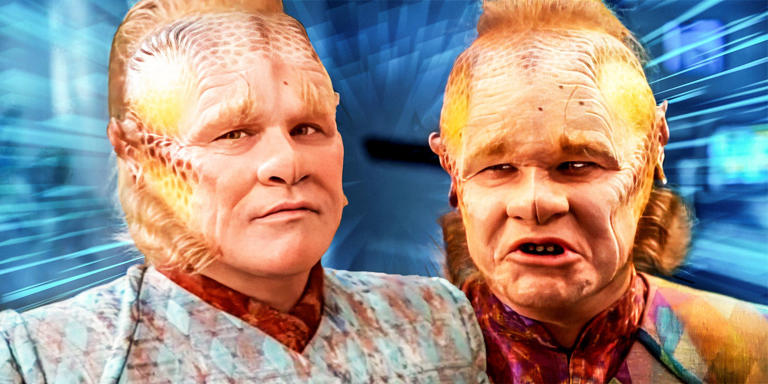
Here’s why USPS employees should follow ethics rules
A new video shows common lapses and how to avoid them.
The Postal Service has released a video that shows the importance of ethical behavior on the job.
The video addresses three common types of ethical lapses: mail destruction, mail theft and misuse of postal property.
The four-minute animated video reminds employees they have a duty to protect the sanctity of the U.S. Mail. Willful acts of mail theft, delay and destruction affect the public’s trust in USPS and hurt the organization’s reputation.
Additionally, the video emphasizes proper use of Voyager cards, which should be used to purchase fuel for postal vehicles. The cards are regularly audited and tracked and should never be used to buy fuel for a personal vehicle, drinks or snacks.
The video, available on the Link website and the Ethics Blue page , will be shown to employees throughout the organization this week and next.
Post-story highlights
More to read.

Do you know the guidelines on contracts?
Ethics rules apply both during and after USPS employment

Do you have a conflict of interest?
Employees should follow the USPS ethics guidelines on outside activities

Considering making an endorsement? Read this first
Footer items.
- Off the Clock
- Week in Review
USPS National Employee Emergency Hotline:
888-363-7462
Weekly highlights
Screen Rant
Star trek: voyager star details cut neelix & kes breakup scene.
Star Trek: Voyager's Ethan Philips talks about the Neelix and Kes' "beautifully written" breakup scene that was filmed, but it never aired.
Star Trek: Voyager star, Ethan Phillips, said that the breakup scene between Neelix and Kes was cut. The science-fiction TV series aired from 1995 to 2001 throughout seven seasons. As the fifth installment of the Star Trek franchise, it follows the Starfleet vessel USS Voyager, which is stuck extremely far from home. They must work with rebels to return to the Federation, a whole 75 years away.
Neelix (Phillips) is a Talaxian who fulfills many jobs across the Voyager, such as cook, ambassador, and navigator. Meanwhile, Kes (Jennifer Lien) is an Ocampan and acts as a nurse on the vessel. While Neelix stars across seven seasons, Kes eventually leaves and never returns after starring in the episode titled "Fury." Neelix and Kes enter a relationship that stretches over the beginning of the series, which was generally panned by audiences and critics. At the same time, it's clear that the two characters part ways on the show; there's no closure to their relationship.
Related: How Star Trek Fixed Neelix's Story Problem In Voyager Season 4
On The Delta Flyers (via TrekMovie ) , Phillips and Tim Russ, who plays Tuvok, talked about the interactions between Neelix and Kes. While the show minimizes the interaction between the two characters, Phillips explained how the show was supposed to have a scene that ultimately was cut before it aired. Even his former co-stars were surprised to hear the news on this. See below for Phillip's account and his co-stars' reactions from the podcast co-hosted by Garrett Wang (Harry Kim) and Robbie McNeill (Tom Paris):
Phillips: “…we did do a scene where we both acknowledge that we’re not a couple anymore. We shot it in the science lab, which was a set we didn’t use often. And Kes and I had a closure conversation where we said we want to be friends now and blah, blah, blah. And it was, it was quite a nice tag to the relationship. They never aired it… …it was it was a very good scene. It was easily as six or seven-page scene where we track what happened to us and what we think might have caused the split, but that we want to stay friends…” Russ: “Time, and they probably couldn’t have—I don’t even know if they had time to maybe edit it down. You know, just to get to the meat of it and get out.” McNeill: “I don’t think that the producers and showrunners of our show valued those kind of relationship stories. They really wanted standalone sci fi concepts, let them play out. They didn’t want to deal with long term relationship consistency or continuity. There was very, very little of it. Tom and B’Elanna got a little bit of that in later seasons, but you know, Garrett and I have even talked about the Chakotay/Janeway relationship and that people get whiplash, too. It’s like, one episode, they have a relationship, then the next episode, they don’t, then they do again, then they don’t, then they do. Which is it? I think what it was was, it was if it was convenient to play that quality in an episode, they would do it if it wasn’t, they wouldn’t. And I think that’s probably what happened with the Kes and Neelix thing.” Phillips: “It was a lot of ambiguity about that relationship to begin with. Was it platonic, wasn’t romantic. And it was shaky, just the the optics You know, I’m an older guy, and here’s this very young girl who’s ostensibly two years old in her race, and I think they weren’t sure how to handle it so much. And so I think they just thought let’s just move on, and maybe they’ll forget about it.”
While it should be noted that the relationship between Neelix and Kes officially ends in season 3's "Warlord," the scene that Phillips referred to in the podcast is in the episode titled "Fair Trade," which is three episodes after. While the show itself only makes a quick reference later on to the fact that they are broken up, although it's a bit strange how the show abandoned this thread. While the show hasn't been on for many years, it's insightful to hear from the cast about filming.
Some fans were under the impression that a scene where Kes is possessed is where their relationship came to a close. While some of the story decisions made don't make a lot of sense, the relationship itself repulsed many viewers, to begin with. It's still often referred to as being creepy, especially given that the relationship lacked nuance regarding how the species work in the context of maturity within the relationship. Even so, the series overall is still perceived quite positively.
Next: Star Trek: Why So Many Shows End After Season 7
Source: TrekMovie / The Delta Flyers

IMAGES
VIDEO
COMMENTS
Kes was a female Ocampa who joined the USS Voyager after it was catapulted into the Delta Quadrant by the Caretaker's array. For over three years she became a valuable member of the crew; she served as a field medic, and was in charge of the airponics bay. She eventually left Voyager in order to explore her increasingly powerful mental abilities. (VOY: "Caretaker", "Eye of the Needle ...
Jennifer Lien left Star Trek: Voyager after playing Kes for three seasons, even though Kes was a central and interesting character. Premiering in 1995, Star Trek: Voyager ushered in a new generation of fans after Star Trek: The Next Generation came to an end. In a unique twist, Captain Janeway's (Kate Mulgrew) starship USS Voyager found itself lost in the Delta Quadrant, and embarked on a ...
At the time, the reasons for Lien leaving the show were a little murky. Writers confessed to feeling they wrote themselves into a corner with her character. But in later years, a sadder truth was ...
Kes is a fictional character played by Jennifer Lien on the American science fiction television show Star Trek: Voyager.She is a part of a telepathic alien species known as the Ocampa who have latent psychic abilities and a life span of only nine years. Joining the starship USS Voyager's crew in the pilot episode "Caretaker", she opens a hydroponics garden and works as the medical assistant to ...
YouTube Jennifer Lien as Kes on Star Trek: Voyager. During the fourth season of Star Trek: Voyager in 1997, the character Kes was suddenly written off the show. At the time, very little was said ...
During Voyager season 2, episode 10, "Cold Fire," Kes learned that she had psychokinetic abilities, including being able to manipulate living and inorganic matter with her mind. Later on, thanks to Voyager 's Species 8472, Kes's powers began to expand so rapidly that she could destabilize things on a molecular level, including her own body.
What makes Culluh especially evil, ... she did get a return episode in Season 6's "Fury" in which Kes went on a misguided quest for revenge against Voyager. Kes was much older due to her ...
The actress, Jennifer Lien, really went all out. Even the inner war between Kes and Tieran was fascinating to watch. Of course fans would love to hate this evil, maniacal, self-righteous mind-invader in a small, sweet woman's body. If only Kes got to be so dynamic all the time (minus the violent, planetary takeover parts).
Cold Fire: Directed by Cliff Bole. With Kate Mulgrew, Robert Beltran, Roxann Dawson, Jennifer Lien. The Caretaker's remains resonate, which might well mean that its mate is nearby. The trail leads to a space colony of Ocampa with psychokinetic powers.
The season six episode "Fury" is one of those. Kes left Voyager after three years because her telepathic abilities were threatening the ship. Now, three more years later, she returns, and she's angry because she couldn't return to Ocampa. She blamed the Voyager crew. She's back with the intention of destroying the ship.
Not So Stoic: Evil Kes can't help smiling when meeting Neelix again. She also looks shocked after trying to dispose of her former mentor Tuvok.; Person of Mass Destruction: What Kes became upon her return.; Red Shirt: Kes psychic-blasts two security personnel along with a large part of the corridor when she first arrives.Averted later on, when the cycle repeats, and Janeway orders the sections ...
Kes was an Ocampa, a race of humanoid beings native to the Delta quadrant, where the USS Voyager was whisked away to by the nefarious caretaker's array. The Ocampans are a race of short-lived ...
Kes' elogium ended when Voyager cleared the aliens' territory. ... Later that year, when The Doctor's program developed a secondary, evil personality as a result of his experimenting with his personality subroutines, the "Dark Doctor", despite his deep resentments, still appeared deep down to care for Kes, albeit in a more twisted fashion than ...
The evil twin also temporarily paralyzes Lt. Torres when she discovers his existence. At the episode's climax, the evil version of the doctor jumps off a cliff with Kes but they get beamed back to Voyager while falling. Upon returning to the ship, the Doctor's program is restored to normal.
Recap /. Star Trek Voyager S 3 E 9 "Warlord". Hell yeah, Evil Kes. Actually, it's a Body Snatcher, and a male one at that. Kes is taken over by the consciousness of a former planetary dictator seeking to regain his throne.
ive just started season 7 but the late season 6 episode with "evil" kes left me with some questions. Voyager has had quite a few time travel episodes like that one and it always makes me wonder at the end of the episode, are we still following the original voyager from episode 1 or is this a completely new voyager several timelines down that were left with by season 7?...i know thats a wierd ...
Star Trek: Prodigy is in many ways a sequel to Star Trek: Voyager, with its initial Delta Quadrant setting and incorporation of Voyager characters Admiral Janeway, Captain Chakotay (Robert Beltran), and the Doctor (Robert Picardo). Kes' nine-year lifespan means she would have passed on by Prodigy season 1 in 2384, but Kes' wish to be a mother is part of Voyager season 2, episode 4 "Elogium ...
The problem a lot of fans have with the on-and-off romantic relationship between Neelix and Kes was the humongous age gap between the two characters. Neelix was in his 30s, while Kes was just two ...
EMH becomes a collection of vague clichés and half-considered nihilism. Abducting Kes, the evil!EMH rants like a supervillain about the raw and undiluted power of evil. To his captive audience, he preaches a truth "that darkness is more fundamental than light. Cruelty before kindness. Evil more primary than good, more deserving of existence."
The Doctor, an Emergency Medical Hologram (or EMH for short), is a fictional character portrayed by actor Robert Picardo on the television series Star Trek: Voyager, which aired on UPN between 1995 and 2001. He is an artificial intelligence manifesting as a holographic projection, designed to act as a short-term supplement to the medical staff of a starship during emergency situations.
Introduced in season 1 alongside his then-girlfriend, Kes (Jennifer Lien), Neelix became a more permanent fixture in Voyager's cast of characters, and his storylines improved exponentially after ...
The character of Neelix got off to a rocky start in popularity on Star Trek: Voyager, but season 4 marked a turning point for him - mostly due to another character's exit from the show. Star Trek: Voyager ran from 1995 to 2001, and followed the crew of the USS Voyager as they journeyed through the Delta Quadrant in an attempt to get home. Neelix was a Talaxian, a Delta Quadrant alien who ...
Additionally, the video emphasizes proper use of Voyager cards, which should be used to purchase fuel for postal vehicles. The cards are regularly audited and tracked and should never be used to buy fuel for a personal vehicle, drinks or snacks.
Star Trek: Voyager star, Ethan Phillips, said that the breakup scene between Neelix and Kes was cut.The science-fiction TV series aired from 1995 to 2001 throughout seven seasons. As the fifth installment of the Star Trek franchise, it follows the Starfleet vessel USS Voyager, which is stuck extremely far from home.They must work with rebels to return to the Federation, a whole 75 years away.